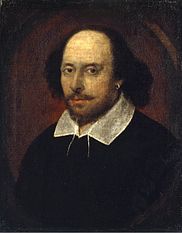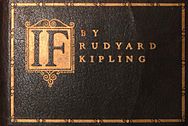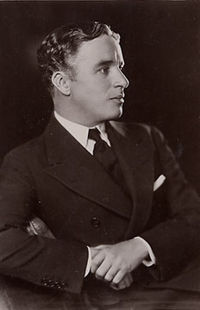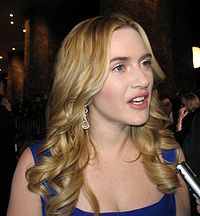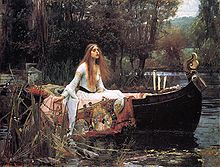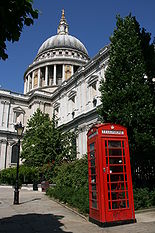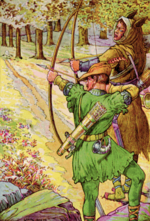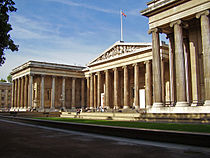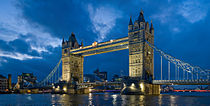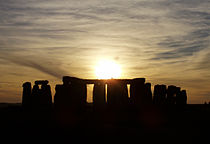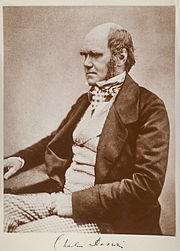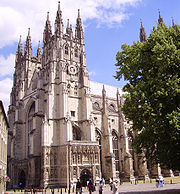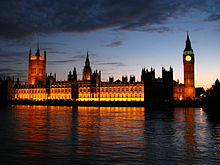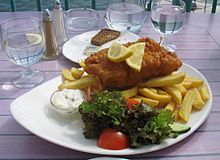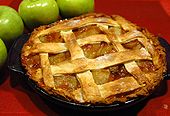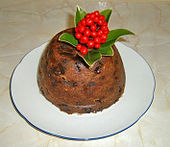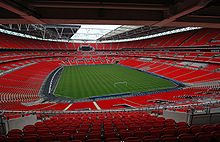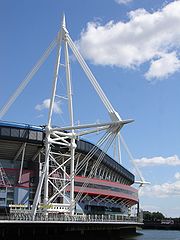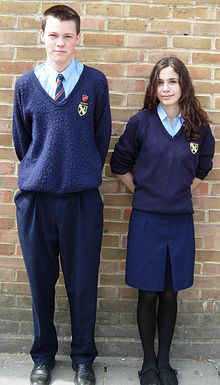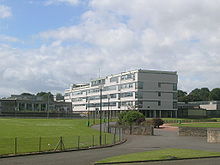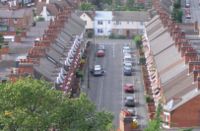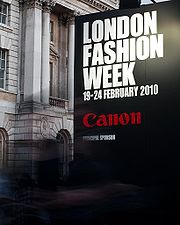- Culture of the United Kingdom
-
 The Proms is an eight-week summer season of daily orchestral classical music concerts, on the last night with some traditional patriotic music of the United Kingdom.[1][2]
The Proms is an eight-week summer season of daily orchestral classical music concerts, on the last night with some traditional patriotic music of the United Kingdom.[1][2]
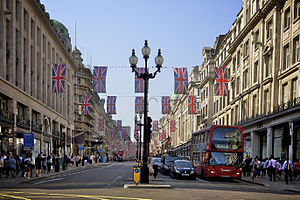 View north up Regent Street, London, on 25 April 2011, with Union Flags hung to celebrate the wedding of Prince William and Kate Middleton
View north up Regent Street, London, on 25 April 2011, with Union Flags hung to celebrate the wedding of Prince William and Kate Middleton
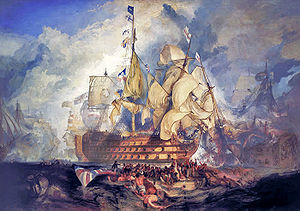 The Battle of Trafalgar is an oil painting executed in 1822, by J. M. W. Turner (c.1775–1851). The experience of military, political and economic power from the rise of the British Empire, led to a very specific drive in artistic technique, taste and sensibility in the United Kingdom.[3]
The Battle of Trafalgar is an oil painting executed in 1822, by J. M. W. Turner (c.1775–1851). The experience of military, political and economic power from the rise of the British Empire, led to a very specific drive in artistic technique, taste and sensibility in the United Kingdom.[3]
The culture of the United Kingdom refers to the patterns of human activity and symbolism associated with the United Kingdom and its people. It is informed by the UK's history as a developed island country, major power, and its composition of four countries—England, Northern Ireland, Scotland and Wales—each of which have preserved distinct customs, cultures and symbolism.
As a direct result of the British Empire, significant British cultural influence (such as the English language) can be observed in the language and culture of a geographically wide assortment of countries including Australia, Canada, India, New Zealand, Nigeria, Pakistan, South Africa, the United States and the British overseas territories. These states are sometimes collectively known as the Anglosphere, and are among Britain's closest allies.[4][5] As well as the British influence on its empire, the empire also influenced British culture, particularly British cuisine. Innovations and movements within the wider culture of Europe have also changed the United Kingdom; Humanism, Protestantism, and representative democracy have developed from broader Western culture.
The Industrial Revolution, with its origins in the UK, brought about major changes in agriculture, manufacturing, and transportation, and had a profound effect on the socio-economic and cultural conditions of the world. The social structure of Britain during this period has also played a central cultural role. More recently, popular culture of the UK included notable movements in music such as the British invasion and Britpop, while British literature, British cinema, British television and British poetry is respected across the world.
As a result of the history of the formation of the United Kingdom, the cultures of England, Scotland, Wales and Northern Ireland are diverse and have varying degrees of overlap and distinctiveness.
Language
The English language is the official language of the UK, and is spoken monolingually by an estimated 95% of the British population.[6][note 1]
However, individual countries within the UK have frameworks for the promotion of their indigenous languages. In Wales, all pupils at state schools must either by taught through the medium of Welsh or study it as an additional language until aged 16, and the Welsh Language Act 1993 and the Government of Wales Act 1998 provide that the Welsh and English languages should be treated equally in the public sector, so far as is reasonable and practicable. Irish and Ulster Scots enjoy limited use alongside English in Northern Ireland, mainly in publicly commissioned translations. The Gaelic Language (Scotland) Act, passed by the Scottish Parliament in 2005, recognised Gaelic as an official language of Scotland, commanding equal respect with English, and required the creation of a national plan for Gaelic to provide strategic direction for the development of the Gaelic language.[note 2]
Under the European Charter for Regional or Minority Languages, which is not legally enforceable, the UK Government has committed to the promotion of certain linguistic traditions. The United Kingdom has ratified the charter for: Welsh (in Wales), Scottish Gaelic and Scots (in Scotland), Cornish (in Cornwall), and Irish and Ulster Scots (in Northern Ireland). British Sign Language is also a recognised language.
The Arts
Literature
Main article: Literature of the United KingdomAt its formation, the United Kingdom immediately inherited the literary traditions of England and Scotland, including the earliest existing native literature written in the Celtic languages, Anglo-Saxon literature and more recent English literature including the works of Geoffrey Chaucer, William Shakespeare and John Milton.
The early 18th century is known as the Augustan Age of English literature. The poetry of the time was highly formal, as exemplified by the works of Alexander Pope and the English novel became popular, with Daniel Defoe's Robinson Crusoe, Henry Fielding's Tom Jones and Samuel Richardson's Pamela.
From the late 18th century, the Romantic period showed a flowering of poetry comparable with the Renaissance two hundred years earlier and a revival of interest in vernacular literature. In Scotland the poetry of Robert Burns revived interest in Scots literature, and the Weaver Poets of Ulster were influenced by literature from Scotland. In Wales the late 18th century saw the revival of the eisteddfod tradition, inspired by Iolo Morganwg.
In the 19th century, major poets in English literature included William Blake, William Wordsworth, Samuel Taylor Coleridge, Alfred Lord Tennyson, John Keats, Elizabeth Barrett Browning, Percy Shelley and Lord Byron. The Victorian period was the golden age of the realistic English novel, represented by Jane Austen, the Brontë sisters (Charlotte, Emily and Anne), Charles Dickens, William Thackeray, George Eliot and Thomas Hardy.
World War I gave rise to British war poets and writers such as Wilfred Owen, Siegfried Sassoon, Robert Graves and Rupert Brooke who wrote (often paradoxically), of their expectations of war, and/or their experiences in the trench.
The most widely popular writer of the early years of the 20th century was arguably Rudyard Kipling. To date the youngest ever recipient of the Nobel Prize for Literature, Kipling's novels include The Jungle Book, The Man Who Would Be King and Kim, while his inspirational poem If— is a national favourite. Like William Ernest Henley's poem Invictus,[11] it is a memorable evocation of Victorian stoicism, a traditional British virtue.[12]
Notable Irish writers include; Oscar Wilde, James Joyce, Bram Stoker, Jonathan Swift, George Bernard Shaw and W. B. Yeats. The Celtic Revival stimulated a new appreciation of traditional Irish literature. The Scottish Renaissance of the early 20th century brought modernism to Scottish literature as well as an interest in new forms in the literatures of Scottish Gaelic and Scots. The English novel developed in the 20th century into much greater variety and was greatly enriched by immigrant writers. It remains today the dominant English literary form.
Other globally well-known British novelists include; George Orwell, C. S. Lewis, Robert Louis Stevenson, Arthur Conan Doyle, H. G. Wells, D. H. Lawrence, Mary Shelley, Lewis Carroll, J. R. R. Tolkien, Virginia Woolf, Ian Fleming, Walter Scott, Agatha Christie, J. M. Barrie, Joseph Conrad, Graham Greene, E. M. Forster, Aldous Huxley, Roald Dahl, Helen Fielding, Arthur C. Clarke, Alan Moore, Ian McEwan, Anthony Burgess, Evelyn Waugh, William Golding, Salman Rushdie, Douglas Adams, P. G. Wodehouse, Martin Amis, Anthony Trollope, Beatrix Potter, A. A. Milne, Philip Pullman, Terry Pratchett, H. Rider Haggard, Neil Gaiman and J. K. Rowling. Important British poets of the 20th century include Rudyard Kipling, Ted Hughes, Philip Larkin, John Betjeman and Dylan Thomas. In 2003 the BBC carried out a UK survey entitled The Big Read in order to find the "nation's best-loved novel" of all time, with works by English novelists Tolkien, Austen, Pullman, Adams and Rowling making up the top five on the list.[13]
Theatre
 The Royal Shakespeare Theatre, opened in Stratford-upon-Avon in 1932, was named after the playwright, William Shakespeare
The Royal Shakespeare Theatre, opened in Stratford-upon-Avon in 1932, was named after the playwright, William Shakespeare Main article: Theatre of the United Kingdom
Main article: Theatre of the United KingdomFrom its formation in 1707, the United Kingdom has had a vibrant tradition of theatre, much of it inherited from England and Scotland. The West End is the main theatre district in the UK, which is located in the West End of London.[14][15] The West End's Theatre Royal in Covent Garden in the City of Westminster dates back to the mid 17th century, making it the oldest London theatre.[16]
In the 18th century, the highbrow and provocative Restoration comedy lost favour, to be replaced by sentimental comedy, domestic tragedy such as George Lillo's The London Merchant (1731), and by an overwhelming interest in Italian opera. Popular entertainment became more important in this period than ever before, with fair-booth burlesque and mixed forms that are the ancestors of the English music hall. These forms flourished at the expense of legitimate English drama, which went into a long period of decline. By the early 19th century it was no longer represented by stage plays at all, but by the closet drama, plays written to be privately read in a "closet" (a small domestic room).
In 1847, a critic using the pseudonym Dramaticus published a pamphlet[17] describing the parlous state of British theatre. Production of serious plays was restricted to the patent theatres, and new plays were subjected to censorship by the Lord Chamberlain's Office. At the same time, there was a burgeoning theatre sector featuring a diet of low melodrama and musical burlesque; but critics described British theatre as driven by commercialism and a 'star' system.[18]
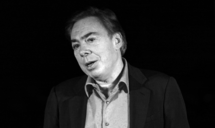 The musicals of Andrew Lloyd Webber have dominated London's West End since the latter half of the 20th century.[19]
The musicals of Andrew Lloyd Webber have dominated London's West End since the latter half of the 20th century.[19]
A change came in the late 19th century with the plays on the London stage by the Irishmen George Bernard Shaw and Oscar Wilde, who influenced domestic English drama and vitalised it again. The Shakespeare Memorial Theatre was opened in Shakespeare's birthplace Stratford upon Avon in 1879; and Herbert Beerbohm Tree founded an Academy of Dramatic Art at Her Majesty's Theatre in 1904.[20] Producer Richard D'Oyly Carte brought together librettist W. S. Gilbert and composer Arthur Sullivan, and nurtured their collaboration.[21] Among Gilbert and Sullivan's best known comic operas are H.M.S. Pinafore, The Pirates of Penzance and The Mikado.[22] Carte built the West End's Savoy Theatre in 1881 to present their joint works, and through the inventor of electric light Sir Joseph Swan, the Savoy was the first theatre, and the first public building in the world, to be lit entirely by electricity.[23][24]
Sadler's Wells, under Lilian Baylis, nurtured talent that led to the development of an opera company, which became the English National Opera (ENO), a theatre company, which evolved into the National Theatre, and a ballet company, which eventually became the English Royal Ballet.[25]
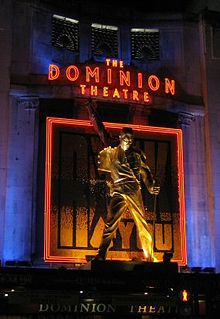 The statue of Freddie Mercury above the West End's Dominion Theatre where Queen and Ben Elton's musical We Will Rock You has been performed since 2002.[26]
The statue of Freddie Mercury above the West End's Dominion Theatre where Queen and Ben Elton's musical We Will Rock You has been performed since 2002.[26]
Making his professional West End debut at the Garrick Theatre in 1911, flamboyant playwright, composer and actor Noël Coward had a career spanning over 50 years, in which he wrote many comic plays, and over a dozen musical theatre works.[27] In July 1962, a board was set up to supervise construction of a National Theatre in London and a separate board was constituted to run a National Theatre Company and lease the Old Vic theatre. The Company was to remain at the Old Vic until 1976, when the new South Bank building was opened. A National Theatre of Scotland was set up in 2006. Today the West End of London has a large number of theatres, particularly centred around Shaftesbury Avenue. A prolific composer of musical theatre in the 20th century, Andrew Lloyd Webber has been referred to as "the most commercially successful composer in history".[19] His musicals which include; The Phantom of the Opera, Cats, Jesus Christ Superstar and Evita, have dominated the West End for a number of years and have travelled to Broadway in New York and around the world as well as being turned into films. Lloyd Webber has worked with producer Sir Cameron Mackintosh, lyricist Sir Tim Rice, actress and singer Sarah Brightman, while his musicals originally starred Elaine Paige, who with continued success has become known as the First Lady of British Musical Theatre.[28]
The Royal Shakespeare Company operates out of Stratford-upon-Avon, producing mainly but not exclusively Shakespeare's plays.[29] Important modern playwrights include Nobel laureate Harold Pinter, Tom Stoppard, Alan Ayckbourn, John Osborne, Michael Frayn and Arnold Wesker.[30][31]
Music
See also: Britpop, British Invasion, British rock, New Wave of British Heavy Metal, List of Britpop musicians, and List of British blues musiciansWhile the British national anthem and other patriotic songs such as "Rule, Britannia!" represent the United Kingdom, each of the four individual countries of the UK also has their own patriotic hymns. Edward Elgar's "Land of Hope and Glory", and Hubert Parry's "Jerusalem" set to William Blake's poem And did those feet in ancient time, are among England's most patriotic hymns.[32] Scottish patriotic songs include "Flower of Scotland", "Scotland the Brave" and "Scots Wha Hae"; patriotic Welsh hymns consist of "Bread of Heaven" and "Land of My Fathers", the latter by tradition is the national anthem of Wales.[33] The patriotic Northern Irish balled Danny Boy is set to the tune "Londonderry Air". Jeremiah Clarke's "Trumpet Voluntary" is popular for wedding music, and has featured in royal weddings.[34]
Other notable British composers; Henry Purcell, Ralph Vaughan Williams, Benjamin Britten, Gustav Holst, William Byrd, Thomas Tallis, Henry Wood, John Taverner, John Blow, Arthur Sullivan, William Walton, John Stafford Smith, Henry Bishop, Ivor Novello, Malcolm Arnold, Michael Tippett and John Barry have made major contributions to British music, and are known internationally. Living composers include Sir George Martin, John Tavener, Harrison Birtwistle, Andrew Lloyd Webber, Oliver Knussen, Harry Gregson Williams, Mike Oldfield, John Rutter, James MacMillan, Joby Talbot, John Powell, David Arnold, Anne Dudley, Trevor Horn, John Murphy, Brian Eno, Clint Mansell, Craig Armstrong and Michael Nyman.
The traditional folk music of England is centuries old and has contributed to several genres prominently; mostly sea shanties, jigs, hornpipes and dance music. It has its own distinct variations and regional peculiarities. Wynkyn de Worde printed ballads of Robin Hood from the 16th century are an important artefact, as are John Playford's The Dancing Master and Robert Harley's Roxburghe Ballads collections.[35] Some of the best known songs are Greensleeves, Scarborough Fair, Pastime with Good Company, Over the Hills and Far Away amongst others. The bagpipes have long been a national symbol of Scotland, and the Great Highland Bagpipe is widely recognised. The most famous Scottish folk song, Auld Lang Syne, is well known throughout the English-speaking world, and is often sung to celebrate the start of the New Year, especially at Hogmanay in Edinburgh.[36]
 The Eagle pub in City Road, London, with Pop Goes the Weasel on the wall. Pubs are a significant aspect of British culture.[37]
The Eagle pub in City Road, London, with Pop Goes the Weasel on the wall. Pubs are a significant aspect of British culture.[37]
From the mid-sixteenth century, nursery rhymes began to be recorded in English plays.[38] Some of the best known nursery rhymes from Britain include; Twinkle Twinkle Little Star, Roses are red, Jack and Jill, Cock a doodle doo, Baa, Baa, Black Sheep, The Grand Old Duke of York, London Bridge Is Falling Down, Hey Diddle Diddle, Three Blind Mice, Little Miss Muffet, Pat-a-cake, Pop Goes the Weasel, One, Two, Buckle My Shoe, Peter Piper, Hickory Dickory Dock, Rock-a-bye Baby, One for Sorrow, This Old Man, Simple Simon, Old Mother Hubbard, Little Bo Peep, Sing a Song of Sixpence, Mary, Mary, Quite Contrary, Old King Cole and Humpty Dumpty.[39]
Christmas carols in English first appear in a 1426 work of John Awdlay, a Shropshire chaplain, who lists twenty five "caroles of Cristemas", probably sung by groups of 'wassailers', who went from house to house.[40] Some of the most notable carols from the UK include; We Wish You a Merry Christmas, O Come All Ye Faithful, The First Noel, God Rest You Merry, Gentlemen, The Holly and the Ivy, I Saw Three Ships, Deck the Halls, In the Bleak Midwinter, Joy to the World, Once in Royal David's City, Hark! The Herald Angels Sing, What Child Is This?, Good King Wenceslas, Here We Come A-Caroling and While Shepherds Watched Their Flocks. The music of Christmas has always been a combination of sacred and secular, and every year in the UK there is a highly publicised competition to be the Christmas number one single, which has led to the production of music which still provides the mainstay of festive playlists. The UK single and album charts are revealed every Sunday on BBC Radio 1, with Elton John's "Candle in the Wind 1997" the all-time best-selling single in the UK, and Queen's Greatest Hits the best-selling album in UK chart history.[41][42]
The Beatles are one of the most commercially successful and critically acclaimed bands in the history of music, selling over a billion records internationally.[43][44][45][46]
The United Kingdom supports a number of major orchestras including the BBC Symphony Orchestra, the Royal Philharmonic Orchestra, the Philharmonia, the London Symphony Orchestra and the London Philharmonic Orchestra. London is one of the world's major centres for classical music: it holds several important concert halls and is also home to the Royal Opera House, one of the world's leading opera houses. British traditional music has also been very influential abroad.
The UK was one of the two main countries in the development of rock music, and has provided global acts including The Beatles, The Rolling Stones, Led Zeppelin, The Who, Pink Floyd, Queen, Elton John, David Bowie, Black Sabbath, Deep Purple, The Kinks, Yardbirds, Sex Pistols, The Clash, Van Morrison, Eric Clapton, Dire Straits, Bee Gees, Rod Stewart, The Animals, Iron Maiden, Def Leppard, Whitesnake, Motörhead, Phil Collins, Duran Duran, Billy Idol, ELO, The Hollies, Sting, Annie Lennox, George Michael, Genesis, The Cure, Siouxsie and the Banshees, The Police, UB40, Ozzy Osbourne, The Smiths, Joy Division, Foreigner, Elvis Costello, Dusty Springfield, Status Quo, Cat Stevens, Judas Priest, Bonnie Tyler, Pet Shop Boys, Joe Cocker, T. Rex, Depeche Mode, Emerson, Lake & Palmer, Roxy Music, The Jam, Rainbow, Kate Bush, Peter Gabriel, Seal, Eurythmics, Free, King Crimson, Moody Blues, The Troggs, Steve Winwood, Robert Palmer, Cream, The Foundations, Herman's Hermits, Procol Harum, Yes, The Pretenders, Simple Minds, The Sweet, Human League, Supertramp, Tears for Fears, New Order, Bad Company, Brian Johnson, The Stone Roses, Pulp, Suede, Manic Street Preachers, Travis, Oasis and Blur. It has provided inspiration for many modern bands of today, including Coldplay, Radiohead, The Verve, Snow Patrol, Gorillaz, Bullet for My Valentine, Muse, Cradle of Filth, Kaiser Chiefs, Placebo, Franz Ferdinand, The Libertines, Bush, The Kooks, Bloc Party, Stereophonics, Keane, Florence and the Machine, Mumford & Sons, Lostprophets and Arctic Monkeys. Since then it has also pioneered various forms of electronic dance music including acid house, drum and bass and trip hop, all of which were in whole or part developed in the United Kingdom. Acclaimed British dance acts include The Prodigy, Massive Attack, Underworld, Orbital, Jamiroquai, Basement Jaxx, The Chemical Brothers, Portishead, Groove Armada, The KLF, Goldfrapp, La Roux, Aphex Twin and Fatboy Slim. Other notable British artists in pop music include Spice Girls, Leona Lewis, Amy Winehouse, Duffy, Lily Allen, Dido, James Blunt, Adele, Imogen Heap, Mika, Kim Wilde, Sade, Fleetwood Mac, Small Faces, Tom Jones, Sarah Brightman, Natasha Bedingfield, Frankie Goes to Hollywood, Culture Club, Davy Jones, Erasure, Simply Red, Gary Numan, Madness and Robbie Williams. British rap is also becoming increasingly popular, mainly within the youth of large cities such as London, Manchester, Birmingham, Nottingham, Leeds and Sheffield. Popular British R&B artists include Taio Cruz, Jay Sean, Tinie Tempah, M.I.A., Tinchy Stryder, Jessie J, Dizzee Rascal, Wiley and N-Dubz.
Cinema
The UK has had a large impact on modern cinema, producing some of the greatest actors, directors and motion pictures of all time including, Sir Alfred Hitchcock, Charlie Chaplin, David Lean, Laurence Olivier, Vivien Leigh, Audrey Hepburn, John Gielgud, Sean Connery, Richard Burton, Vanessa Redgrave, Michael Caine, Anthony Hopkins and Daniel Day-Lewis. The BFI Top 100 British films is a poll conducted by the British Film Institute which ranks what they consider to be the 100 greatest British films of all time. Two of the biggest actors in the silent era were Charlie Chaplin and Stan Laurel. English photographer Eadweard Muybridge pioneered motion picture,[47] while pioneering Scottish documentary maker John Grierson coined the term "documentary" to describe a non-fiction film in 1926.[48] Hitchcock's Blackmail (1929), is regarded as the first British sound feature,[49] while The 39 Steps (1935) features a signature Hitchcock cameo. Sir Alexander Korda's The Private Life of Henry VIII (1933), was the first British production to be nominated for the Academy Award for Best Picture. Boris Karloff played the leading role in several major Hollywood horror movies in the 1930s. Famous for recording many motion picture film scores, the London Symphony Orchestra first performed film music in 1935.[50] The first British Academy Film Awards ceremony took place in 1947. Sir Laurence Olivier starred in and directed Henry V (1944), and Hamlet (1948), the latter being the first non-American film to win the Academy Award for Best Picture and also picked up the BAFTA Award for Best Film. The third Shakespearean film directed by Olivier was Richard III (1955). The British film-making partnership of Powell and Pressburger made a series of influential films in the 1940s and 1950s, with The Red Shoes (1948) their most commercially successful film. Carol Reed directed The Third Man (1949), regarded among the best British films of the 20th century.
David Lean emerged as a major filmmaker in the 1940s with Brief Encounter (1945) and Great Expectations (1946), and his first big-screen epic The Bridge on the River Kwai (1957) won seven Academy Awards. Towards the end of the 1950s, Hammer Films embarked on their series of influential and wildly successful horror films, including lavish colour versions of Frankenstein (1957), Dracula (1958) and The Mummy (1959), with actors Peter Cushing and Christopher Lee at the forefront. A West Country native where many well known English pirates hailed from, Robert Newton's portrayal of Long John Silver in 1950s films popularized the stereotypical West Country pirate accent.[51] Films that explored the "Swinging London" phenomenon of the 1960s included, Alfie (1966), Blowup (1966) and Bedazzled (1967). The James Bond film series began in the early 1960s, with Sean Connery in the leading role. After The Beatles films A Hard Day's Night (1964) and Help! (1965), it became standard for each new pop group to have a verité style feature film made about them.
Other major British films of 60s included Lawrence of Arabia (1962), Tom Jones (1963), Zulu (1964) and Those Magnificent Men in Their Flying Machines (1965). Four of the decade's Academy Award winners for best picture were British productions, including six Oscars for the film musical Oliver! (1968), based on Charles Dickens' novel Oliver Twist. British actors in starring roles in 1960s films included Sir Alec Guinness, Richard Burton, Peter Sellers, Audrey Hepburn, Julie Christie, Michael Caine, Rex Harrison, Julie Andrews and David Niven. In the 1970s, Ronald Neame directed the festive favourite Scrooge (1970), while adaptations of Agatha Christie stories Murder on the Orient Express (1974) and Death on the Nile (1978) were critically acclaimed. British musical comedy film The Rocky Horror Picture Show (1975) featuring Tim Curry, is the longest-running theatrical release in film history.[53][54] In the mid 1970s, seminal British comedy team Monty Python switched their attention to movies, beginning with Monty Python and the Holy Grail (1975), followed by Monty Python's Life of Brian (1979), the latter regularly voted the funniest film of all time by the British public.[55][56] Hollywood blockbusters that were filmed at major British studios in 1977-79, include Star Wars (featuring Alec Guinness) at Elstree Studios, Superman II (featuring Terence Stamp) at Pinewood, and Alien (directed by Ridley Scott) at Shepperton.
 The Odeon cinema in Leicester Square, London during screening of Casino Royale in 2006.[57] The cinema hosts numerous European and World film premieres.[58][59]
The Odeon cinema in Leicester Square, London during screening of Casino Royale in 2006.[57] The cinema hosts numerous European and World film premieres.[58][59]
British films won back to back Academy Award for best picture in the 1980s, with Chariots of Fire (1982), followed by Gandhi (1983). John Hurt won the BAFTA Award for Best Actor for his titular role as 19th century Englishman Joseph Merrick in The Elephant Man (1980). Richard Marquand directed Star Wars Episode VI: Return of the Jedi in 1983, the only non-American to direct a Star Wars film. The 1990s saw a large number of traditional British period dramas, including Sense and Sensibility (1995), Restoration (1995), Emma (1996), Mrs. Brown (1997), The Wings of the Dove (1997), Shakespeare in Love (1998) and Topsy-Turvy (1999). Anthony Minghella's biggest directorial success was The English Patient (1996), winning nine Academy Awards. English film composer Michael Nyman wrote the critically acclaimed score for The Piano (1993). Elton John and lyricist Sir Tim Rice collaborated to write music for Disney's The Lion King (1994), winning the Academy Award for Best Original Song, as did Phil Collins for Disney's Tarzan (1999). Scottish composer Craig Armstrong wrote the award winning score for the modern version of Shakespeare's Romeo + Juliet (1996). BAFTA award winning British films included Danny Boyle's drama Trainspotting (1996) that centres on life in Edinburgh, the 1997 comedy The Full Monty set in Sheffield, and the biographical drama Elizabeth (1998). Richard Curtis's scripted Four Weddings and a Funeral (1994), set a pattern for British-set romantic comedies, including Sliding Doors (1998) and Notting Hill (1999).
At the turn of the century, three major international British successes were the romantic comedies Bridget Jones's Diary (2001), sequel Bridget Jones: The Edge of Reason (2004), and Richard Curtis's directorial debut Love Actually (2003). In 2000, Leavesden Film Studios began filming the first installment of the Harry Potter film series.[60] English composer Clint Mansell's score for Requiem for a Dream has been well received,[61] and its main theme Lux Aeterna has gained wide usage in popular culture and has featured in a number of film trailers. Famous for his creation Mr. Bean, the much celebrated comedian Rowan Atkinson starred in Johnny English (2003). Wallace and Gromit creator and four time Academy Award winning animator Nick Park directed Chicken Run (2000) and Wallace & Gromit: The Curse of the Were-Rabbit (2005). Helen Mirren starred as Elizabeth II in The Queen (2006), winning Academy and Bafta Awards for best actress. Danny Boyle's Slumdog Millionaire (2008) was the most successful British film of the decade, receiving critical acclaim and won eight Academy Awards.[62] Historical drama The King's Speech (2010), featuring Colin Firth as George VI, received widespread acclaim, won four Academy Awards and seven Baftas, and is being hailed as the most successful independent British film ever.[63][64]
The five most commercially successful British directors in recent years are David Yates, Christopher Nolan, Mike Newell, Ridley Scott and Paul Greengrass.[65] Other contemporary British film directors include Guy Ritchie, Alan Parker, Tony Scott, Terry Gilliam, Richard Attenborough, Kenneth Brannagh, Paul W. S. Anderson, Tom Hooper, Edgar Wright, Matthew Vaughn and Sam Mendes.
British actors and actresses have always been significant in international cinema. Well-known currently active performers include the likes of Catherine Zeta-Jones, Ian McKellen, Clive Owen, Jude Law, Rachel Weisz, Ewan McGregor, Kate Winslet, Hugh Grant, Colin Firth, Daniel Radcliffe, Daniel Craig, Emma Watson, Keira Knightley, Ralph Fiennes, Orlando Bloom, Tilda Swinton, Daniel Day-Lewis, Christian Bale, Jason Statham, Idris Elba, Paul Bettany, Mischa Barton, Emma Thompson, Kate Beckinsale, Michael Sheen, Helena Bonham Carter, Hugh Laurie, Ben Kingsley, Christopher Lee, Alan Rickman, Jason Isaacs, John Hurt, Emily Blunt, Sienna Miller, Bill Nighy, Carey Mulligan, Ray Winstone, Peter O' Toole, Jeremy Irons, Gary Oldman, Helen Mirren, Liam Neeson, Tim Roth, Robert Pattinson, Julie Andrews, Sean Bean, Gemma Arterton, Gerard Butler, Tom Hardy, Russell Brand, Patrick Stewart, Judi Dench, Anthony Hopkins, Michael Caine and Sacha Baron Cohen.
 The Wallace Monument, Stirling, Scotland, commemorates William Wallace, the 13th-century Scottish hero depicted in Braveheart (1995).
The Wallace Monument, Stirling, Scotland, commemorates William Wallace, the 13th-century Scottish hero depicted in Braveheart (1995).
Hollywood films with a British dimension have had enormous worldwide commercial success. Many of the highest-grossing films worldwide of all time have a British historical, cultural or creative theme. Films based on British historical events; RMS Titanic,[66] Piracy in the Caribbean,[67] Mutiny on the Bounty,[68] The Great Escape,[69] historical people; William Wallace, Lawrence of Arabia, King Arthur, Elizabeth I, British stories; The Lord of the Rings, Harry Potter, James Bond, The Chronicles of Narnia, Sherlock Holmes, Frankenstein, A Christmas Carol, Charlie and the Chocolate Factory, Treasure Island, The War of the Worlds among many others, while British video game Tomb Raider featuring English archaeologist Lara Croft, has been made into feature films. British influence can also be seen with the 'English Cycle' of Disney animated films, which feature Alice in Wonderland, Peter Pan, The Jungle Book, Robin Hood, The Hundred and One Dalmatians, The Sword in the Stone, The Rescuers and Winnie the Pooh.[70]
Broadcasting
The UK has been at the forefront of developments in film, radio, and television. Broadcasting in the UK has historically been dominated by the BBC, although independent radio and television (ITV, Channel 4, Five) and satellite broadcasters (especially BSkyB which has over 10 million subscribers[71]) have become more important in recent years. BBC television, and the other three main television channels are public service broadcasters who, as part of their license allowing them to operate, broadcast a variety of minority interest programming. The BBC and Channel 4 are state-owned, though they operate independently.
Many successful British TV shows have been exported around the world, such as Pop Idol (created by Simon Fuller), Who Wants to Be a Millionaire?, Britain's Got Talent (created by Simon Cowell), The X Factor, Hell's Kitchen (created by Gordon Ramsay), The Office (created by Ricky Gervais), Ramsay's Kitchen Nightmares, Strictly Come Dancing, Doctor Who and Top Gear. The British Film Institute drew up a list of the 100 Greatest British Television Programmes in 2000, voted by industry professionals.[72] In 2004 the BBC conducted a nationwide poll to find "Britain's Best Sitcom".[73]
The United Kingdom has a large number of national and local radio stations which cover a great variety of programming. The most listened to stations are the five main national BBC radio stations. BBC Radio 1, a new music station aimed at the 16-24 age group. BBC Radio 2, a varied popular music and chat station aimed at adults is consistently highest in the ratings. BBC Radio 4, a varied talk station, is noted for its news, current affairs, drama and comedy output as well as The Archers, its long running soap opera, and other unique programmes. The BBC, as a public service broadcaster, also runs minority stations such as BBC Asian Network, BBC 1xtra and BBC 6 Music, and local stations throughout the country. Talksport is one of the biggest commercial radio stations in the UK.[74]
- List of British radio channels
- List of British television channels
Visual arts
From the creation of the United Kingdom, the English school of painting is mainly notable for portraits and landscapes, and indeed portraits in landscapes. Among the artists of this period are Sir Joshua Reynolds (1723–1792), George Stubbs (1724–1806), and Thomas Gainsborough (1727–1788). William Hogarth painted far more down-to-earth portraits and satires, and was the first great English printmaker.
The late 18th century and the early 19th century was perhaps the most radical period in British art, producing William Blake (1757–1827), John Constable (1776–1837) and William Turner (1775–1851), three of the most influential British artists, each of whom have dedicated spaces allocated for their work at the Tate Britain.[75]
The Pre-Raphaelite Brotherhood (PRB) achieved considerable influence after its foundation in 1848 with paintings that concentrated on religious, literary, and genre subjects executed in a colourful and minutely detailed style. PRB artists included John Everett Millais, Dante Gabriel Rossetti and subsequently Edward Burne-Jones. Also associated with it was the designer William Morris, whose efforts to make beautiful objects affordable (or even free) for everyone led to his wallpaper and tile designs to some extent defining the Victorian aesthetic and instigating the Arts and Crafts movement.
Visual artists from the United Kingdom in the 20th century include Francis Bacon (an Anglo-Irishman), David Hockney, Bridget Riley, and the pop artists Richard Hamilton and Peter Blake. Also prominent amongst twentieth century artists was Henry Moore, regarded as the voice of British sculpture, and of British modernism in general.[76] Sir Jacob Epstein was a pioneer of modern sculpture. In 1958 artist Gerald Holtom designed the protest logo for the British CND, which later became a universal peace symbol used in many different versions worldwide.[77] As a reaction to abstract expressionism, pop art emerged originally in England at the end of the 1950s. Known for his thickly impasted portrait and figure paintings, Lucian Freud was widely considered the pre-eminent British artist of his time.[78] The 1990s saw the Young British Artists, Damien Hirst and Tracey Emin.
Randolph Caldecott, Walter Crane, Kate Greenaway, John Tenniel, Aubrey Beardsley, Roger Hargreaves, Arthur Rackham, John Leech, George Cruikshank and Beatrix Potter were notable book illustrators. The subversive political artwork of Banksy (pseudonym of the renowned English graffiti artist whose identity is concealed) can be found on streets, walls and buildings all over the world, and has also featured in TV shows.[79][80] Arts institutions include the Royal College of Art, Royal Society of Arts, New English Art Club, Slade School of Art, Royal Academy, and the Tate Gallery (founded as the National Gallery of British Art).
Architecture
The architecture of the United Kingdom includes many features that precede the creation of the United Kingdom in 1707, from as early as Skara Brae and Stonehenge to the Giant's Ring, Avebury and Roman ruins. In most towns and villages the parish church is an indication of the age of the settlement. Many castles remain from the medieval period such as; Windsor Castle (longest-occupied castle in Europe),[82] Stirling Castle (one of the largest and most important in Scotland),[83] Bodiam Castle (moated castle), and Warwick Castle. Over the two centuries following the Norman conquest of England of 1066, and the building of the Tower of London, castles such as Caernarfon Castle in Wales and Carrickfergus Castle in Ireland were built.
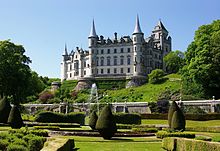 Dunrobin Castle, Scotland, designed by the architect Charles Barry. Today there are thousands of castles throughout the UK.[84]
Dunrobin Castle, Scotland, designed by the architect Charles Barry. Today there are thousands of castles throughout the UK.[84]
English Gothic architecture flourished from the 12th to the early 16th century, and famous examples include; Westminster Abbey, the traditional place of coronation for the British monarch (also has a long tradition as a venue for royal weddings)[85] Canterbury Cathedral, one of the oldest and most famous Christian structures in England, Salisbury Cathedral, has the tallest church spire in the UK,[86] and Winchester Cathedral, contains the longest nave and overall length of any Gothic cathedral in Europe.[87]
In the United Kingdom, a listed building is a building or other structure officially designated as being of special architectural, historical or cultural significance. About half a million buildings in the UK have "listed" status.
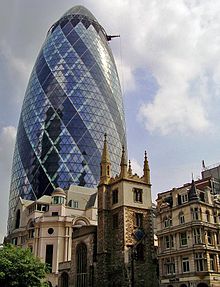 Norman Foster's 'Gherkin' (2004) rises above the 13th century church St. Andrew Undershaft in the City of London. The architecture of the United Kingdom is diverse
Norman Foster's 'Gherkin' (2004) rises above the 13th century church St. Andrew Undershaft in the City of London. The architecture of the United Kingdom is diverse
In the 1680s, Downing Street was built by Sir George Downing, and its most famous address 10 Downing Street, became the residence of the Prime Minister in 1730.[88] One of the best known English architects working at the time of the foundation of the United Kingdom was Sir Christopher Wren. He was employed to design and rebuild many of the ruined ancient churches of London following the Great Fire of London. His masterpiece, St Paul's Cathedral, was completed in the early years of the United Kingdom.[89] Buckingham Palace, the official London residence of the British monarch, was built in 1705.[90]
In the early 18th century baroque architecture — popular in Europe — was introduced, and Blenheim Palace was built in this era. However, baroque was quickly replaced by a return of the Palladian form. The Georgian architecture of the 18th century was an evolved form of Palladianism. Many existing buildings such as Woburn Abbey and Kedleston Hall are in this style. Among the many architects of this form of architecture and its successors, neoclassical and romantic, were Robert Adam, Sir William Chambers, and James Wyatt.
The aristocratic stately home continued the tradition of the first large gracious unfortified mansions such as the Elizabethan Montacute House and Hatfield House. During the 18th and 19th centuries to the highest echelons of British society, the English country house served as a place for relaxing, hunting and running the countryside. Many stately homes have become open to the public; Knebworth House, now a major venue for open air rock and pop concerts,[91] Alton Towers, theme park and the most popular in the UK,[92] and Longleat, the world's first safari park outside Africa.[93][94]
In the early 19th century the romantic medieval gothic style appeared as a backlash to the symmetry of Palladianism, and such buildings as Fonthill Abbey were built. By the middle of the 19th century, as a result of new technology, construction was able to develop incorporating steel as a building component; one of the greatest exponents of this was Joseph Paxton, architect of the Crystal Palace. Paxton also continued to build such houses as Mentmore Towers, in the still popular retrospective Renaissance styles. In this era of prosperity and development British architecture embraced many new methods of construction, but ironically in style, such architects as August Pugin ensured it remained firmly in the past.
At the beginning of the 20th century a new form of design arts and crafts became popular, the architectural form of this style, which had evolved from the 19th century designs of such architects as George Devey, was championed by Edwin Lutyens. Arts and crafts in architecture is symbolized by an informal, non symmetrical form, often with mullioned or lattice windows, multiple gables and tall chimneys. This style continued to evolve until World War II.
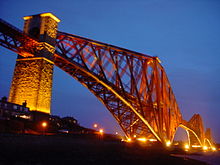 The Forth Railway Bridge is a cantilever bridge over the Firth of Forth in the east of Scotland. It was opened in 1890, and is designated as a Category A listed building.
The Forth Railway Bridge is a cantilever bridge over the Firth of Forth in the east of Scotland. It was opened in 1890, and is designated as a Category A listed building.
Following the Second World War, reconstruction went through a variety of phases, but was heavily influenced by Modernism, especially from the late 1950s to the early 1970s. Many bleak town centre redevelopments—criticised for featuring hostile, concrete-lined "windswept plazas"—were the fruit of this interest, as were many equally bleak public buildings, such as the Hayward Gallery. Many Modernist inspired town centres are today in the process of being redeveloped, Bracknell town centre being a case in point.
However, in the immediate post-War years many thousands (perhaps hundreds of thousands) of council houses in vernacular style were built, giving working class people their first experience of private gardens and indoor sanitation.
Modernism remains a significant force in UK architecture, although its influence is felt predominantly in commercial buildings. The two most prominent proponents are Lord Rogers of Riverside and Norman Foster. Rogers' iconic London buildings are probably Lloyd's Building and the Millennium Dome, while Foster created the 'Gherkin' and the City Hall. When completed in 2012, the Shard London Bridge will be the tallest building in the European Union.[95] Other major skyscrapers under construction in London include The Pinnacle, and Heron Tower.[96][97] Modernist architect Nicholas Grimshaw designed the Eden Project in Cornwall, which is the world's largest greenhouse.[98]
Performing arts
Large outdoor music festivals in the summer and autumn are popular, such as Glastonbury, V Festival, Reading and Leeds Festivals. The most prominent opera house in England is the Royal Opera House at Covent Gardens.[99] The Proms, a season of orchestral classical music concerts held at the Royal Albert Hall, is a major cultural event held annually.[99] The Royal Ballet is one of the world's foremost classical ballet companies, its reputation built on two prominent figures of 20th century dance, prima ballerina Margot Fonteyn and choreographer Frederick Ashton. The Edinburgh Festival Fringe is the world’s largest arts festival.[100] Established in 1947, it takes place in Scotland's capital during three weeks every August alongside several other arts and cultural festivals. The Fringe mostly attracts events from the performing arts, particularly theatre and comedy, although dance and music also figure significantly.[100]
The circus is a traditional form of entertainment in the UK. Chipperfield's Circus dates back more than 300 years in Britain, making it one of the oldest family circus dynasties.[94] Philip Astley is regarded as the father of the modern circus. Following his invention of the circus ring in 1768,[101] Astley's Amphitheatre opened in London in 1773. As an equestrian master Astley had a genius for trick horse-riding, and when he added tumblers, tightrope-walkers, jugglers, performing dogs, and a clown to fill time between his own demonstrations — the modern circus was born.[102][103] Having began his theatrical career with Hughes Royal Circus in London in the 1780s, Englishman John Bill Ricketts brought the modern circus to the US in 1792, and he gave America's first complete circus performance in Philadelphia on April 3, 1793.[102] Joseph Grimaldi is the most celebrated of English clowns, and is widely considered the father of modern clowning.[104][105]
Folklore
Much of the folklore of the United Kingdom pre-dates the UK. Though some of the characters and stories are present across Britain, most belong to specific countries or regions. Common folkloric beings include pixies, giants, elfs, bogeymen, trolls, goblins and dwarves. While many legends and folk-customs are thought to be ancient, for instance the tales featuring Offa of Angeln and Weyland Smith,[106] others date from after the Norman invasion; Robin Hood and his Merry Men of Sherwood and their battles with the Sheriff of Nottingham being, perhaps, the best known.[107]
During the High Middle Ages tales originated from Brythonic traditions, notably the Arthurian myth.[108][109][110] Deriving from Welsh source; King Arthur, Excalibur and Merlin, while the Jersey poet Wace introduced the Knights of the Round Table. These stories are most centrally brought together within Geoffrey of Monmouth's Historia Regum Britanniae. Another early figure from British tradition, King Cole, may have been based on a real figure from Sub-Roman Britain. Many of the tales and pseudo-histories make up part of the wider Matter of Britain, a collection of shared British folklore.
The Loch Ness Monster is a cryptid that is reputed to inhabit Loch Ness in the Scottish Highlands. The legendary monster has been affectionately referred to by the nickname Nessie since the 1950s.[111] The Leprechaun figures large in Irish folklore. A mischievous fairy type creature in emerald green clothing who when not playing tricks spend all their time busily making shoes, the Leprechaun is said to have a pot of gold hidden at the end of the rainbow, and if ever captured by a human it has the magical power to grant three wishes in exchange for release.[112] In mythology, English fairytales such as Jack and the Beanstalk helped form the modern perception of giants as stupid and violent, while the legendary dwarf Tom Thumb is a traditional hero in English folklore. Some folk figures are based on semi or actual historical people whose story has been passed down centuries; Lady Godiva for instance was said to have ridden naked on horseback through Coventry, the heroic English figure Hereward the Wake resisted the Norman invasion, Herne the Hunter is an equestrian ghost associated with Windsor Forest and Great Park, and Mother Shipton is the archetypal witch.[113] The chivalrous bandit, such as Dick Turpin, is a recurring character, while the colourful English pirates Blackbeard and Calico Jack are renowned.[67] The Gremlin is part of RAF folklore dating from the 1920s, with gremlin being RAF slang for a mishievous creature that sabotages aircraft, meddling in the planes equipment.[114] Legendary figures from nineteenth century London whose tales have been romanticised include Sweeney Todd, the murderous barber of Fleet Street, and serial killer Jack the Ripper. On 5 November, people in England make bonfires, set off fireworks and eat toffee apples in commemoration of the foiling of the Gunpowder Plot centred around Guy Fawkes, which became an annual event after The Thanksgiving Act of 1606 was passed.[115] Halloween is a traditional and much celebrated holiday in Ireland and Scotland on the night of October 31.[116] The name Halloween is first attested in the 16th century as a Scottish shortening of the fuller All-Hallows-Even,[117] and according to some historians has its roots in the gaelic festival Samhain, where the Gaels believed the border between this world and the otherworld became thin, and the dead would revisit the mortal world.[118] In 1780, Dumfries poet John Mayne makes note of pranks at Halloween; "What fearfu' pranks ensue!", as well as the supernatural associated with the night, "Bogies" (ghosts).[119] The bard of Scotland Robert Burns' 1785 poem Halloween is recited by Scots at Halloween, and Burns was influenced by Mayne's composition.[119][120] In Scotland and Ireland, traditional Halloween customs include; Guising — children disguised in costume going from door to door requesting food or coins — which became practice by the late 19th century,[121][122] turnips hollowed-out and carved with faces to make lanterns,[123] holding parties where games such as apple bobbing are played.[124] Other practices in Ireland include lighting bonfires, and having firework displays.[125][126] Further contemporary imagery of Halloween is derived from Gothic and Horror literature (notably Shelley's Frankenstein and Stoker's Dracula), and classic horror films (such as Hammer Horrors). Mass transatlantic Irish and Scottish migration in the 19th century popularized Halloween in North America.[127]
Museums, libraries, and galleries
Heritage administration
Each country of the United Kingdom has its own body responsible for heritage matters.
English Heritage is the governmental body with a broad remit of managing the historic sites, artefacts and environments of England. It is currently sponsored by the Department for Culture, Media and Sport. The charity National Trust for Places of Historic Interest or Natural Beauty holds a contrasting role. Seventeen of the twenty-five United Kingdom UNESCO World Heritage Sites fall within England.[129] Some of the best known of these include; Hadrian's Wall, Stonehenge, Avebury and Associated Sites, Tower of London, Jurassic Coast, Westminster, Saltaire, Ironbridge Gorge, Studley Royal Park and various others.[130]
Historic Scotland is the executive agency of the Scottish Government, responsible for historic monuments in Scotland, such as Stirling Castle. The Old and New Town of Edinburgh is a notable Scottish World Heritage site.
Many of Wales' great castles, such as the Castles and Town Walls of King Edward in Gwynedd and other monuments, are under the care of Cadw, part of the Welsh Assembly Government.
The Northern Ireland Environment Agency promotes and conserves the natural and built environment in Northern Ireland, and The Giants Causeway in the northeast coast, is one of the UK's natural World Heritage sites.[130]
Museums and galleries
Further information: Museums in England, Museums in Scotland, Museums in Wales, and Museums in Northern IrelandThe British Museum in London with its collection of more than seven million objects,[131] is one of the largest and most comprehensive in the world,[132] sourced from every continent, illustrating and documenting the story of human culture from its beginning to the present. National Museums of Scotland bring together national collections in Scotland. Amgueddfa Cymru – National Museum Wales comprises eight museums in Wales.
The most senior art gallery is the National Gallery in Trafalgar Square, which houses a collection of over 2,300 paintings dating from the mid-13th century to 1900.[133] The Tate galleries house the national collections of British and international modern art; they also host the famously controversial Turner Prize.[134] The National Galleries of Scotland are the five national galleries of Scotland and two partner galleries. The National Museum of Art, Wales, opened in 2011.[135]
Libraries
The British Library in London is the national library and is one of the world's largest research libraries, holding over 150 million items in all known languages and formats; including around 25 million books.[136] The National Library of Scotland in Edinburgh, holds 7 million books, fourteen million printed items and over 2 million maps.[137] The National Library of Wales is the national legal deposit library of Wales.[138]
Science and technology
Main article: Science and technology in the United KingdomFrom the time of the Scientific Revolution, England and Scotland, and thereafter the United Kingdom, have been prominent in world scientific and technological development. The Royal Society serves as the national academy for sciences, with members drawn from many different institutions and disciplines. Formed in 1660, it is the oldest learned society still in existence.
Sir Isaac Newton's publication of the Principia Mathematica ushered in what is recognisable as modern physics. The first edition of 1687 and the second edition of 1713 framed the scientific context of the foundation of the United Kingdom. He realised that the same force is responsible for movements of celestial and terrestrial bodies, namely gravity. He was the father of classical mechanics, formulated as his three laws and as the co-inventor (with Gottfried Leibniz) of differential calculus. He also created the binomial theorem, worked extensively on optics, and created a law of cooling.
Since Newton's time, figures from the UK have contributed to the development of most major branches of science. Examples include Michael Faraday, who, with James Clerk Maxwell, unified the electric and magnetic forces in what are now known as Maxwell's equations; James Joule, who worked extensively in thermodynamics and is often credited with the discovery of the principle of conservation of energy; Paul Dirac, one of the pioneers of quantum mechanics; naturalist Charles Darwin, author of On the Origin of Species and discoverer of the principle of evolution by natural selection; Harold Kroto, the discoverer of buckminsterfullerene; William Thomson (Baron Kelvin) who drew important conclusions in the field of thermodynamics and invented the Kelvin scale of absolute zero; botanist Robert Brown discovered the random movement of particles suspended in a fluid (Brownian motion); and the creator of Bell's Theorem, John Stewart Bell. Other British pioneers in their field include; Joseph Lister (Antiseptic surgery), Edward Jenner (Vaccination), Florence Nightingale (Nursing), Richard Owen (Palaeontology), Sir George Cayley (Aerodynamics), William Fox Talbot (Photography), Howard Carter (Modern Archaeology, discovered Tutankhamun), James Hutton (Modern Geology).[139]
John Harrison invented the marine chronometer, a key piece in solving the problem of accurately establishing longitude at sea, thus revolutionizing and extending the possibility of safe long distance sea travel.[140] The most celebrated British explorers include James Cook, Walter Raleigh, Sir Francis Drake, Henry Hudson, George Vancouver, Sir John Franklin, David Livingstone, Captain John Smith, Robert Falcon Scott, Lawrence Oates and Ernest Shackleton.
William Sturgeon invented the electromagnet in 1824.[141][142] The first commercial electrical telegraph was co-invented by Sir William Fothergill Cooke and Charles Wheatstone. Cooke and Wheatstone patented it in May 1837 as an alarm system, and it was first successfully demonstrated on 25 July 1837 between Euston and Camden Town in London.[143][144] Postal reformer Sir Rowland Hill is regarded as the creator of the modern postal service and the inventor of the postage stamp (Penny Black) — with his solution of pre-payment facilitating the safe, speedy and cheap transfer of letters.[145] Hill's colleague Sir Henry Cole introduced the world's first commercial Christmas card in 1843.[146] In 1851 Sir George Airy established the Royal Observatory, Greenwich, London, as the location of the prime meridian where longitude is defined to be 0° (the point that divides the Earth into the Eastern and Western Hemispheres).[147]
Historically, many of the UK's greatest scientists have been based at either Oxford or Cambridge University, with laboratories such as the Cavendish Laboratory in Cambridge and the Clarendon Laboratory in Oxford becoming famous in their own right. In modern times, other institutions such as the Red Brick and New Universities are catching up with Oxbridge. For instance, Lancaster University has a global reputation for work in low temperature physics.
 A Watt steam engine, the steam engine that propelled the Industrial Revolution in Britain and the world.[148]
A Watt steam engine, the steam engine that propelled the Industrial Revolution in Britain and the world.[148]
Technologically, the UK is also amongst the world's leaders. Historically, it was at the forefront of the Industrial Revolution, with innovations especially in textiles, the steam engine, railroads and civil engineering. Famous British engineers and inventors from this period include James Watt, Robert Stephenson, Richard Arkwright, and the 'father of Railways' George Stephenson. Engineer Isambard Kingdom Brunel was placed second in a 2002 BBC nationwide poll to determine the "100 Greatest Britons".[149] He is best known for creating the Great Western Railway, as well as famous steamships including the SS Great Britain, the first propeller-driven ocean-going iron ship, and SS Great Eastern which laid the first lasting transatlantic telegraph cable.[150] Josiah Wedgwood pioneered the industrialisation of pottery manufacture.[151]
Since then, the United Kingdom has continued this tradition of technical creativity. Alan Turing (leading role in the creation of the modern computer),[152] Scottish inventor Alexander Graham Bell (the first practical telephone),[153] John Logie Baird (world's first working television system, first electronic colour television),[154][155] Frank Whittle (inventor of the jet engine), Charles Babbage (who devised the idea of the computer) and Alexander Fleming (discoverer of penicillin)[156] were all British. The UK remains one of the leading providers of technological innovations today, providing inventions as diverse as the World Wide Web by Sir Tim Berners-Lee, and Viagra by British scientists at Pfizer's Sandwich, Kent.[157] Sir Alec Jeffreys pioneered DNA fingerprinting.[158] Pioneers of fertility treatment Patrick Steptoe and Robert Edwards, successfully achieved conception through IVF (world's first "test tube baby").[159][160]
Other famous scientists, engineers, theorists and inventors from the UK include: Sir Francis Bacon, Richard Trevithick (Train), Thomas Henry Huxley, Francis Crick (DNA), Rosalind Franklin (Photo 51), Robert Hooke, Humphry Davy, Robert Watson-Watt, J. J. Thomson (discovered Electron), James Chadwick (discovered Neutron), Frederick Soddy (discovered Isotope), John Cockcroft, Henry Bessemer, Edmond Halley, Sir William Herschel, Charles Parsons (Steam turbine), Alan Blumlein (Stereo sound), John Dalton (Colour blindness), James Dewar, Alexander Parkes (celluloid), Charles Macintosh, Ada Lovelace, Peter Durand, Alcock & Brown (first non-stop transatlantic flight), Henry Cavendish (discovered Hydrogen), Francis Galton, Sir Joseph Swan (Incandescent light bulb), Sir William Gull (Anorexia nervosa), Frank Pantridge, George Everest, Edward Whymper (first ascent of Matterhorn), Daniel Rutherford, Arthur Eddington (luminosity of stars), Lord Rayleigh (why sky is blue), Norman Lockyer (discovered Helium)[161] Julian Huxley (formed WWF), Adam Smith (pioneer of modern economics and capitalism), John Herschel, Bertrand Russell (analytic philosophy pioneer), Richard Dawkins, Stephen Hawking, Joseph Priestly and others.
Religion
See also: Religion in England, Religion in Northern Ireland, Religion in Scotland, and Religion in WalesThe United Kingdom was created as an Anglican Christian country and Anglican churches remain the largest faith group in each country of the UK.[162] Following this is Roman Catholicism and religions including Islam, Hinduism, Sikhism, Judaism, and Buddhism. Today British Jews number around 300 000 with the UK having the fifth largest Jewish community worldwide.[163] While 2001 census information[164] suggests that over 75 percent of UK citizens consider themselves to belong to a religion, Gallup International reports that only 10 percent of UK citizens regularly attend religious services. A 2004 YouGov poll found that 44 percent of UK citizens believe in God, while 35 percent do not.[165] The Christian festivals of Christmas and Easter are national public holidays in the UK,[166] and Christian organisations, such as the Salvation Army founded by William Booth, play an important role for their charitable work.[167]
Politics
See also: Politics of England, Politics of Scotland, Politics of Wales, and Politics of Northern IrelandThe UK has a parliamentary government based on the Westminster system that has been emulated around the world — a legacy of the British Empire. The Parliament of the United Kingdom that meets in the Palace of Westminster has two houses: an elected House of Commons and an appointed House of Lords, and any Bill passed requires Royal Assent to become law. It is the ultimate legislative authority in the United Kingdom since the devolved parliament in Scotland and devolved assemblies in Northern Ireland, and Wales are not sovereign bodies and could be abolished by the UK parliament despite being established following public approval as expressed in referendums.
The UK's three major political parties are the Labour Party, the Conservative Party, and the Liberal Democrats, who most recently won between them 622 out of 650 seats available in the House of Commons: 621 seats at the 2010 general election and 1 more at the delayed by-election in Thirsk and Malton. Most of the remaining seats were won by parties that only contest elections in one part of the UK such as the Scottish National Party (Scotland only), Plaid Cymru (Wales only), and the Democratic Unionist Party, Social Democratic and Labour Party, Ulster Unionist Party, and Sinn Féin (Northern Ireland).
 Winston Churchill, historically ranked the greatest British prime minister, giving his famous 'V' sign
Winston Churchill, historically ranked the greatest British prime minister, giving his famous 'V' sign
The United Kingdom has an uncodified constitution, the Constitution of the United Kingdom, consisting mostly of a collection of disparate written sources, including statutes, judge-made case law, and international treaties. As there is no technical difference between ordinary statutes and "constitutional law," the UK Parliament can perform "constitutional reform" simply by passing Acts of Parliament and thus has the political power to change or abolish almost any written or unwritten element of the constitution. However, no Parliament can pass laws that future Parliaments cannot change.[168]
Major British constitutional documents include; Magna Carta (foundation of the "great writ" Habeas corpus — safeguarding individual freedom against arbitrary state action), the Bill of Rights 1689 (one provision granting freedom of speech in Parliament), Petition of Right, Habeas Corpus Act 1679 and Parliament Acts 1911 and 1949.[169] A separate but similar document, the Claim of Right Act, applies in Scotland. The jurist Albert Venn Dicey wrote that the British Habeas Corpus Acts "declare no principle and define no rights, but they are for practical purposes worth a hundred constitutional articles guaranteeing individual liberty".[170] A strong advocate of the "unwritten constitution", Dicey highlighted that English rights were embedded in the general English common law of personal liberty, and "the institutions and manners of the nation".[171] Important British political figures include; Emmeline Pankhurst, leader of the suffragettes which helped win women the right to vote,[172] William Wilberforce, leading abolitionist,[173] Robert Peel, founded the Conservative party and is also credited with the creation of the modern police force.[174] Britain took a leading role in the movement to abolish slavery worldwide, and in 1839 the world's oldest international human rights organisation, Anti-Slavery International, was formed in Britain, which worked to outlaw slavery in other countries.[175] The world's largest human rights organisation, Amnesty International, was founded by Peter Benenson in London in 1961.[176]
Cuisine
British cuisine is the specific set of cooking traditions and practices associated with the United Kingdom. Historically, British cuisine means "unfussy dishes made with quality local ingredients, matched with simple sauces to accentuate flavour, rather than disguise it."[177] However, British cuisine has absorbed the cultural influence of those that settled in Britain, producing hybrid dishes, such as the Anglo-Indian Chicken tikka masala, hailed as "Britain's true national dish".[178][179]
British cuisine has traditionally been limited in its international recognition to the full breakfast and the Christmas dinner.[180] However, Celtic agriculture and animal breeding produced a wide variety of foodstuffs for indigenous Celts. Anglo-Saxon England developed meat and savoury herb stewing techniques before the practice became common in Europe. The Norman conquest introduced exotic spices into Great Britain in the Middle Ages.[180] The British Empire facilitated a knowledge of India's elaborate food tradition of "strong, penetrating spices and herbs".[180]
The first recipe for ice cream was published in Mrs. Mary Eales's Receipts in London 1718.[181] The 18th-century English aristocrat John Montagu, 4th Earl of Sandwich is most renowned for the claim to have originated the modern concept of the sandwich which was named after him. It is said that he ordered his valet to bring him meat tucked between two pieces of bread, and because Montagu also happened to be the Fourth Earl of Sandwich, others began to order "the same as Sandwich!".[182] In 1767, Joseph Priestley invented carbonated water (also known as soda water), the major and defining component of most soft drinks.[183][184]
Each country within the United Kingdom has its own specialities. Traditional examples of English cuisine include the Sunday roast; featuring a roasted joint, usually beef, lamb or chicken, served with assorted boiled vegetables, Yorkshire pudding and gravy.[185] Other prominent meals include fish and chips and the full English breakfast—consisting of bacon, grilled tomatoes, fried bread, black pudding, baked beans, fried mushrooms, sausages and eggs. The first chips fried in Britain were at Oldham's Tommyfield Market in 1860, and on the site a blue plaque marks the origin of the fish and chip shop and fast food industries in Britain.[186] Various meat pies are consumed such as steak and kidney pie, shepherd's pie, cottage pie, Cornish pasty and pork pie, the later of which is consumed cold.[185]
Sausages are commonly eaten, either as bangers and mash or toad in the hole. Lancashire hotpot is a well known stew. Some of the most popular cheeses are Cheddar and Wensleydale. Many Anglo-Indian hybrid dishes, curries, have been created such as chicken tikka masala and balti. Sweet English dishes include apple pie, mince pies, spotted dick, scones, Eccles cakes, pancakes, sponge cake, Battenberg cake, Jaffa cakes, trifle, custard, and sticky toffee pudding. Common drinks include tea, which became far more widely drunk due to Catherine of Braganza.[188] The public house is an important aspect of British culture,[37] and alcoholic drinks include wines and English beers such as bitter, mild, stout, and brown ale.[189] Scottish cuisine includes Arbroath Smokie and Haggis; Irish cuisine features the Ulster fry and Irish Stew and Welsh cuisine is noted for Welsh rarebit. Whisky dates back to Ireland and Scotland in the Middle Ages, with each producing their own unique brand, Irish Whiskey and Scotch Whisky.[190][191] On Christmas Day, turkey is traditionally served at dinner, and Christmas pudding for dessert.[187] The 16th-century English navigator William Strickland is credited with introducing the turkey into England, and his family coat of arms showing a turkey cock as the family crest, is one of the earliest known pictures of a turkey.[192] Since being invented in London in the 1840s, Christmas crackers are an integral part of Christmas celebrations, often pulled before or after dinner, or at parties.[193]
Sport
Most of the major sports have separate administrative structures and national teams for each of the countries of the United Kingdom. Though each country is also represented individually at the Commonwealth Games, there is a single 'Team GB' that represents the UK at the Olympic Games.
The most popular sport in the UK is association football.[194] The rules were first codified in England in 1863, and the UK has the oldest football clubs in the world. The home nations all have separate national teams and domestic competitions, most notably England's Barclays Premier League and FA Cup, and the Scottish Premier League and Scottish Cup. The first ever international football match was between Scotland and England in 1872. The English Premier League (formed in 1992 by member clubs of the old Football League First Division) is the most-watched football league in the world,[195] and its biggest clubs include Manchester United, Liverpool, Arsenal and Chelsea.
Scotland's Celtic and Rangers also have a global fanbase. The best-placed teams in the domestic leagues of England and Scotland qualify for Europe's premier competition, the UEFA Champions League, where the competition's anthem, written by English composer Tony Britten, is played before each game.[196] Football in Britain is renowned for the intense rivalries between clubs and the passion of the supporters.[197]
The modern game of golf originated in Scotland, with the Fife town of St Andrews known internationally as the Home of golf[198] and to many golfers the Old Course, an ancient links course dating to before 1574, is considered to be a site of pilgrimage.[199] Golf is documented as being played on Musselburgh Links, East Lothian, Scotland as early as 2 March, 1672, which is certified as the oldest golf course in the world by Guinness World Records.[200] The oldest known rules of golf were compiled in March 1744 in Leith.[201] The oldest golf tournament in the world, and the first major championship in golf, The Open Championship, first took place in Ayrshire, Scotland in 1860, and today it is played on the weekend of the third Friday in July.[202] Golf's first superstar Harry Vardon, a member of the fabled Great Triumvirate who were pioneers of the modern game, won the Open a record six times.[203] The 'Queensberry rules', the code of general rules in boxing, was named after John Douglas, 9th Marquess of Queensberry in 1867, that formed the basis of modern boxing.[204] Britain's first heavyweight world champion Bob Fitzsimmons made boxing history as the sport's first three-division world champion.[205][206] The modern game of cricket was created in England in the 1830s when round arm bowling was legalised, followed by the historical legalisation of overarm bowling in 1864.[207] In 1876–77, an England team took part in the first-ever Test match against Australia. Hugely influential in terms of his importance to the development of the sport, W. G. Grace is regarded as one of the greatest cricket players of all time, and devised most of the techniques of modern batting.[208] The rivalry between England and Australia gave birth to The Ashes in 1882 that has remained Test cricket's most famous contest, and takes place every two years. The County Championship is the domestic competition in England and Wales.
In 1845, rugby union was created when the first rules were written by pupils at Rugby School, Warwickshire.[209] A former pupil of the school William Webb Ellis, is often fabled with the invention of running with the ball in hand in 1823.[210] The first rugby international took place on 27 March 1871, played between England and Scotland.[211] By 1881 both Ireland and Wales had teams, and in 1883 the first international competition the annual Home Nations Championship took place. In 1888, the Home Nations combined to form what is today called the British and Irish Lions, who now tour every four years to face a Southern Hemisphere team.[212] The major domestic club competitions are the Premiership in England and the Celtic League in Ireland, Scotland, Wales and (since 2010) Italy. In 1895, rugby League was created in Huddersfield, West Yorkshire, as the result of a split with the other Rugby code.[213] The Super League is the sports top-level club competition in Britain. Since the 1920s, Henry Lyte's Christian hymn "Abide With Me" is sung prior to kick-off at every rugby league Challenge Cup final, and football's FA Cup Final.[213][214]
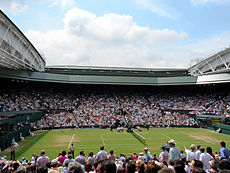 Centre Court at Wimbledon. First played in 1877, the Wimbledon Championships is the oldest tennis tournament in the world.[215]
Centre Court at Wimbledon. First played in 1877, the Wimbledon Championships is the oldest tennis tournament in the world.[215]
The modern game of tennis originated in the UK in the 1870s,[216] and after its creation, tennis spread throughout the upper-class English-speaking population, before spreading around the world.[217] Major Walter Clopton Wingfield is credited as being a pioneer of the game.[218] The oldest tennis tournament in the world the Wimbledon championships, first occurred in 1877, and today the event takes place over two weeks in late June and early July.[215] The eight-time Slam winner and Britain's most successful player Fred Perry, is one of only seven men in history to have won all four Grand Slam events.[219] Originating in 17th and 18th-century England, the Thoroughbred is a horse breed best known for its use in horse racing. Horse racing was popular with the aristocrats and royalty of British society, earning it the title "Sport of Kings."[220] The National Hunt horse race the Grand National, is held annually at Aintree Racecourse in early April, and three-time winner Red Rum is the most successful racehorse in the events history.[221] Other famous sporting events in the UK include the Formula One British Grand Prix at Silverstone, the London Marathon, and The Boat Race on the River Thames. In 2002 Channel 4 broadcast the 100 Greatest Sporting Moments, as voted for by the UK public.[222] A great number of major sports originated in the United Kingdom, including association football, golf, tennis, boxing, rugby league, rugby union, cricket, field hockey, snooker, billiards, squash, curling and badminton, all of which are popular in Britain. Another sport invented in the UK was baseball,[223][224] and its early form rounders is popular among children in Britain.[225]
Education
Each country of the United Kingdom has a separate education system. Power over education matters in Scotland, Wales and Northern Ireland is devolved but education in England is dealt with by the UK government since there is no devolved administration for England.
England
Most schools came under state control in the Victorian era, a formal state school system was instituted after the Second World War. Initially schools were separated into infant schools (normally up to age 4 or 5), primary schools and secondary schools (split into more academic grammar schools and more vocational secondary modern schools). Under the Labour governments of the 1960s and 1970s most secondary modern and grammar schools were combined to become comprehensive schools. England has many prominent private schools, often founded hundreds of years ago, which are known as public schools or independent schools. Eton, Harrow and Rugby are three of the better known. Most primary and secondary schools in both the private and state sectors have compulsory school uniforms. Allowances are almost invariably made, however, to accommodate religious dress including the Islamic hijab and Sikh bangle (kara).
Although the Minister of Education is responsible to Parliament for education, the day to day administration and funding of state schools is the responsibility of Local Education Authorities.
England's universities include some of the highest-ranked universities in the world; the University of Cambridge, Imperial College London, the University of Oxford and University College London are all ranked in the global top 10 in the 2010 QS World University Rankings.[226] The London School of Economics has been described as the world's leading social science institution for both teaching and research.[227] The London Business School is considered one of the world's leading business schools and in 2010 its MBA programme was ranked best in the world by the Financial Times.[228] Academic degrees in England are usually split into classes: first class (I), upper second class (II:1), lower second class (II:2) and third (III), and unclassified (below third class).
Northern Ireland
The Northern Ireland Assembly is responsible for education in Northern Ireland though responsibility at a local level is administered by 5 Education and Library Boards covering different geographical areas.
Scotland
Scotland has a long history of universal provision of public education which, traditionally, has emphasised breadth across a range of subjects compared to depth of education over a smaller range of subjects at secondary school level. The majority of schools are non-denominational, but by legislation separate Roman Catholic schools, with an element of control by the Roman Catholic Church, are provided by the state system. Qualifications at the secondary school and post-secondary (further education) level are provided by the Scottish Qualifications Authority and delivered through various schools, colleges and other centres. Political responsibility for education at all levels is vested in the Scottish Parliament and the Scottish Executive Education and Enterprise, Transport & Lifelong Learning Departments. State schools are owned and operated by the local authorities which act as Education Authorities, and the compulsory phase is divided into primary school and secondary school (often called High school, with the world's oldest high school being the Royal High School (Edinburgh) in 1505,[229][230] and spread to the New World owing to the high prestige enjoyed by the Scottish educational system.). Schools are supported in delivering the National Guidelines and National Priorities by Learning and Teaching Scotland.
Scottish universities generally have courses a year longer than their counterparts elsewhere in the UK, though it is often possible for students to take a more advanced specialised exams and join the courses at the second year. One unique aspect is that the ancient universities of Scotland issue a Master of Arts as the first degree in humanities. The University of Edinburgh is world class and among the top twenty univerities in the world according to the QS_World_University_Rankings 2011. It is also one among the Ancient Universities in Great Britain.
Wales
The National Assembly for Wales has responsibility for education in Wales. A significant number of students in Wales are educated either wholly or largely through the medium of Welsh and lessons in the language are compulsory for all until the age of 16. There are plans to increase the provision of Welsh Medium schools as part of the policy of having a fully bi-lingual Wales.
Outdoor education
Scouting is the largest co-educational youth Movement in the UK.[231] Scouting began in 1907 when Robert Baden-Powell, Lieutenant General in the British Army, held the first Scout camp at Brownsea Island in Dorset, England.[232] Baden-Powell wrote the principles of Scouting in Scouting for Boys in 1908.[233] In 2010, Scouting in the UK experienced its biggest growth spurt since 1972, taking total membership to almost 500,000.[231]
Sociological issues
Housing
The UK has one of the highest population densities in the world.[234] Housing, therefore, tends to be more closely packed than in other countries, resulting in a particular affinity with the terraced house, dating back to the aftermath of the Great Fire of London.[235]
As the first industrialised country in the world, the UK has long been urbanised.[236] In the twentieth century, the process of suburbanisation led to a spread of semi-detached and detached housing. In the aftermath of the second world war, public housing was dramatically expanded to create a large number of council estates, although the majority of these have since been purchased by their tenants.
There is a wealth of historic country houses and stately homes in rural areas, though the majority of these are now put to other uses than private living accommodation.
In recent times, more detached housing has started to be built. Also, city living has boomed with city centre population's rising rapidly. Most of this population growth has been accommodated through new apartment blocks in residential schemes, such as those in Leeds, Birmingham and Manchester.
Demographic changes (see below) are putting great pressure on the housing market, especially in London and the South East.
Living arrangements
Historically most people in the United Kingdom lived either in conjugal extended families or nuclear families. This reflected an economic landscape where the general populace tended to have less spending power, meaning that it was more practical to stick together rather than go their individual ways. This pattern also reflected gender roles. Men were expected to go out to work and women were expected to stay at home and look after the families.
In the 20th century the emancipation of women, the greater freedoms enjoyed by both men and women in the years following the Second World War, greater affluence and easier divorce have changed gender roles and living arrangements significantly. The general trend is a rise in single people living alone, the virtual extinction of the extended family (outside certain ethnic minority communities), and the nuclear family arguably reducing in prominence.
From the 1990s, the breakup of the traditional family unit, when combined with a low interest rate environment and other demographic changes, has created great pressure on the housing market, in particular regarding the accommodation of key workers such as nurses, other emergency service workers and teachers, who are priced out of most housing, especially in the South East.
Some research indicates that in the 21st century young people are tending to continue to live in the parental home for much longer than their predecessors.[237][238] The high cost of living, combined with rising cost of accommodation, further education and higher education means that many young people cannot afford to live independent lives from their families.
National costume and dress
As a multi-national state,[239][240] the UK has no single national costume. However, different countries within the United Kingdom have national costumes or at least are associated with styles of dress. Scotland has the kilt and Tam o'shanter, and tartan clothing — pattern consisting of criss-crossed horizontal and vertical bands in multiple colours — is a notable aspect of Gaelic culture.[241] A traditional Welsh costume with Welsh hat is worn by some women during Eisteddfodau. In England certain military uniforms such as the Beefeater or the Queen's Guard are considered to be symbolic of Englishness, though they are not official national costumes. Morris dancers or the costumes for the traditional English May dance are sometimes cited as examples of traditional English costume, but are only worn by participants in those events.
This is in large part due to the critical role that British sensibilities have played in world clothing since the eighteenth century. Particularly during the Victorian era, British fashions defined acceptable dress for men of business. Key figures such as the future Edward VII, Edward VIII, and Beau Brummell, created the modern suit and cemented its dominance. Brummell is credited with introducing and establishing as fashion the modern man's suit, worn with a tie.[242] The tradition of a white wedding is commonly credited to Queen Victoria's choice to wear a white wedding dress at her wedding to Prince Albert in 1840, at a time when white was associated with purity and conspicuous consumption (because it was difficult to keep clean, and thus could not be worn by servants or laborers), and when it was the color required of girls being presented to the royal court.[243][244]
Fashion
London, as one of the world's four fashion capitals, is host to the London Fashion Week - one of the 'Big Four' fashion weeks.[245] Organised by the British Fashion Council, the event takes place twice each year, in February and September. The current venue for most of the "on-schedule" events is Somerset House in central London, where a large marquee in the central courtyard hosts a series of catwalk shows by top designers and fashion houses,[246] while an exhibition, housed within Somerset House itself, showcases over 150 designers.[247] However, many "off-schedule" events, such as On|Off and Vauxhall Fashion Scout, are organised independently and take place at other venues in central London.[248] British designers whose collections have been showcased at the fashion week include Vivienne Westwood, Alexander McQueen and Stella McCartney, while British models who have featured at the event include Kate Moss, Naomi Campbell, Jade Jagger, Jodie Kidd and Rosie Huntington-Whiteley.[249] Fashion designer Mary Quant was at the heart of the "Swinging London" scene of the 1960s, and her work culminated in the creation of the miniskirt and hot pants.[250] Quant named the miniskirt after her favourite make of car, the Mini.[251] The English fashion designer Charles Frederick Worth is widely considered the father of Haute couture.[252][253]
Floral emblems
Each of the four countries of the UK has a traditional floral emblem. The red rose is the national flower of England,[254] and its use dates from the reign of Henry VII who chose a red rose, representing Lancaster, and a white rose, representing York.[254] As a result the English civil wars in the 15th-century came to be called the Wars of the Roses.[255] The national flower in Scotland is the thistle,[256] Northern Ireland the shamrock,[257] and in Wales the daffodil and leek.[258] The Union rose, shamrock and thistle is engrafted on the same stem on the coat of arms of the United Kingdom.[259]
Greeting cards
The sending and receiving of greeting cards is an established tradition in the UK, with card sending or card display in the home being an important part of British culture.[260] Sending Valentine's Day cards became hugely popular in Britain in the late 18th century, a practice that has since spread to other nations.[261] Today in the UK just under half the population spend money on their Valentines.[262] Following Sir Rowland Hill's postal reforms in the 1830s, the reduction in postal rates with the invention of the postage stamp (Penny Black) made sending greeting cards an affordable means of personal communication.[145] Invented by Sir Henry Cole in 1843, the Christmas card accounts for almost half of the volume of greeting card sales in the UK, with over 600 million cards sold annually.[260] Other popular occasions for sending greeting cards in the UK are Birthdays, Mother’s Day, Easter and Father’s Day.[260][263]
Naming convention
The common naming convention throughout the United Kingdom is for everyone to have a given name (a forename, still often referred to as a Christian name) usually (but not always) indicating the child's sex, followed by a family name (surname).[264] Since the 19th century middle names have become very common and are often taken from the name of a family ancestor.
Most surnames of British origin fall into seven types:
- Occupations e.g. Smith, Sawyer, Fuller, Brewer, Clark, Cooper, Cook, Carpenter, Bailey, Parker, Forrester, Head, Palmer, Archer, Hunt, Baker, Miller, Dyer, Walker, Woodman, Taylor, Turner, Knight, Slater, Mason, Weaver, Carter, Wright
- Personal characteristics e.g., Short, Brown, Black, Whitehead, Young, Long, White
- Geographical features e.g., Bridge, Camp, Hill, Bush, Lake, Lee, Wood, Holmes, Forest, Underwood, Hall, Brooks, Fields, Stone, Morley, Moore, Perry
- Place names e.g., Murray, Everingham, Burton, Leighton, Hamilton, Sutton, Flint, Laughton
- Estate For those descended from land-owners, the name of their holdings, manor or estate
- Patronymics, matronymics or ancestral, often from a person's given name. e.g., from male name: Richardson, Jones (Welsh for John), Williams, Jackson, Wilson, Thompson, Johnson, Harris, Evans, Simpson, Willis, Fox, Davies, Reynolds, Adams, Dawson, Lewis, Rogers, Murphy, Nicholson, Robinson, Powell, Ferguson, Davis, Edwards, Hudson, Roberts, Harrison, Watson, or female names Molson (from Moll for Mary), Gilson (from Gill), Emmott (from Emma), Marriott (from Mary) or from a clan name (for those of Scottish origin, e.g., MacDonald, Forbes, Henderson, Armstrong, Grant, Cameron, Stewart, Douglas, Crawford, Campbell, Hunter) with "Mac" Scottish Gaelic for son.[265]
- Patronal from patronage (Hickman meaning Hick's man, where Hick is a pet form of the name Richard) or strong ties of religion Kilpatrick (follower of Patrick) or Kilbride (follower of Bridget).
Traditionally, Christian names were those of Biblical characters or recognised saints; however, in the Gothic Revival of the Victorian era, other Anglo Saxon and mythical names enjoyed something of a fashion among the literati. Since the middle of the 20th century, however, first names have been influenced by a much wider cultural base.
See also:
- Most popular names of England and Wales
- Most popular names of Northern Ireland
- Most popular names of Scotland
- Most common surnames in England
- Most common surnames in Northern Ireland
- Most common surnames in Scotland
- Most common surnames in Wales
See also
- British humour
- Department for Culture, Media and Sport (deals with Culture for England)
- Minister for Culture and External Affairs (deals with Culture for Scotland)
- Shrove Tuesday (Pancake Day)
- April Fools' Day
- Lord Kitchener Wants You
Notes
- ^ English is established by de facto usage. In Wales, the Bwrdd yr Iaith Gymraeg is legally tasked with ensuring that, "in the conduct of public business and the administration of justice, the English and Welsh languages should be treated on a basis of equality". Welsh Language Act 1993, Office of Public Sector Information, http://www.opsi.gov.uk/acts/acts1993/Ukpga_19930038_en_2.htm, retrieved 3 September 2007 Bòrd na Gàidhlig is tasked with "securing the status of the Gaelic language as an official language of Scotland commanding equal respect to the English language" Gaelic Language (Scotland) Act 2005, Office of Public Sector Information, http://www.opsi.gov.uk/legislation/scotland/acts2005/asp_20050007_en_1, retrieved 9 March 2007 Archived 1 February 2010 at WebCite
- ^ Under the European Charter for Regional or Minority Languages the Welsh, Scottish Gaelic, Cornish, Irish, Ulster Scots and Scots languages are officially recognised as Regional or Minority languages by the UK Government ( European Charter for Regional or Minority Languages, Scottish Executive, http://www.scotland.gov.uk/Topics/ArtsCulture/gaelic/gaelic-english/17910/europeancharter, retrieved 23 August 2007) See also Languages of the United Kingdom. Archived 1 February 2010 at WebCite
References
- ^ The Last Night, bbc.co.uk, 2008, http://www.bbc.co.uk/proms/2008/lastnight/, retrieved 2008-10-22
- ^ Hamilton, James, Last Night of the Proms brought to a rousing finale with patriotic splendour, sundayherald.com, http://www.sundayherald.com/news/heraldnews/display.var.2446128.0.last_night_of_the_proms_brought_to_a_rousing_finale_with_patriotic_splendour.php, retrieved 2008-10-22
- ^ McKenzie, John, Art and Empire, britishempire.co.uk, http://www.britishempire.co.uk/art/artandempire.htm, retrieved 2008-10-24
- ^ Swaine, Jon (13 Jan 2009) Barack Obama presidency will strengthen special relationship, says Gordon Brown The Daily Telegraph. Retrieved 3 March 2010.
- ^ E. J. Kirchner and J. Sperling, Global Security Governance: Competing Perceptions of Security in the 21st Century (London: Taylor & Francis, 2007), p. 100.
- ^ BBC - Languages - United Kingdom BBC
- ^ Dobson, Michael (1992), The making of the national poet, p.185–186. Oxford, England: Oxford University Press.
- ^ New Scots Makar opens Robert Burns Birthplace Museum BBC News. Retrieved 15 June 2011
- ^ Mike Robinson (2004) Literature and tourism[dead link]
- ^ Emma Jones (2004) The Literary Companion Robson, 2004.
- ^ Boehmer, Elleke (2008). "Nelson Mandela: a very short introduction". (Oxford University Press). http://books.google.com/books?id=2EFHq0C1LSAC&pg=PA157&dq=Nelson+Mandela:+a+very+short+introduction+invictus&hl=en&ei=xZpLTO2YOILw0wSeruCECw&sa=X&oi=book_result&ct=result&resnum=1&ved=0CDEQ6AEwAA#v=onepage&q&f=false. "Invictus, taken on its own, Mandela clearly found his Victorian ethic of self-mastery"
- ^ Films and British national identity: from Dickens to Dad's army p.327. Manchester University Press, 1997
- ^ BBC - The Big Read - Top 100 Books. Retrieved 2010-27-11.
- ^ West End theatres in London enjoy record-breaking year BBC News'.' Retrieved 26 March 2011.
- ^ London Theatreland. Retrieved 26 March 2011.
- ^ Theatre Royal Drury Lane Victorian Web'.' Retrieved 26 March 2011.
- ^ Dramaticus The stage as it is (1847)
- ^ James Woodfield (1984) British theatre in transition, 1889-1914 p.94. Rowman & Littlefield. Retrieved 26 May 2011
- ^ a b Sondheim and Lloyd-Webber: the new musical The New York Times.. referred to Andrew Lloyd-Webber as "the most commercially successful composer in history"
- ^ The Royal Academy of Dramatic Art (RADA). Retrieved 16 March 2011.
- ^ Crowther, Andrew (28 June 1997). "The Carpet Quarrel Explained". The Gilbert and Sullivan Archive. http://math.boisestate.edu/gas/html/quarrel.html. Retrieved 2007-11-06.
- ^ Davis, Peter G (21 January 2002). "Smooth Sailing". http://nymag.com/nymetro/arts/music/classical/reviews/5596/. Retrieved 2007-11-06.
- ^ "The Savoy Theatre", The Times, 3 October 1881
- ^ Description of lightbulb experiment in The Times, 28 December 1881
- ^ The Royal Ballet School: A Brief History. Retrieved 16 March 2011.
- ^ For the first time ever...Queen: Ten great hits from the sensational rock band The Mail On Sunday'.' Retrieved 22 January 2011.
- ^ Show Business: Noel Coward at 70 Time Magazine'.' Retrieved 16 March 2011.
- ^ BBC - Radio 2 - Elaine Paige BBC Radio
- ^ The Royal Shakespeare Company: About the Plays. Retrieved 16 March 2011.
- ^ The Nobel Prize in Literature 2005 - Harold Pinter. Retrieved 16 March 2011. Archived 1 February 2010 at WebCite
- ^ Profile of Tom Stoppard; "And now the real thing" The Guardian. Retrieved 16 March 2011.
- ^ And Did Those Feet? - Jerusalem - Icons of England
- ^ Welsh Icons - Land of My Fathers
- ^ Dan Fox (2007) World's Greatest Wedding Music: 50 of the Most Requested Wedding Pieces p.7. Alfred Music Publishing, 2007 Retrieved 4 January 2011
- ^ Chappell, William (1966). The Roxburghe Ballads. New York: AMS Press, 1966
- ^ Geddes MacGregor Scotland: An Intimate Portrait p.249. Houghton Mifflin Harcourt, 1990
- ^ a b Mike Storry (2007) British cultural identities p.148. Routledge, 2007[dead link]
- ^ A. Fox, Oral and Literate Culture in England, 1500-1700 p. 202. (Oxford University Press, 2000)
- ^ Lax, Roger (1989). The Great Song Thesaurus. Oxford University Press, 1989
- ^ Miles, Clement, Christmas customs and traditions, pp. 47-48. Courier Dover Publications, 1976
- ^ The UK's Best Selling Singles. Retrieved 3 February 2011.
- ^ Queen head all-time sales chart BBC'.' Retrieved 3 February 2011. Archived 16 January 2010 at WebCite
- ^ 1960-1969, EMI Group Ltd, archived from the original on 2008-05-28, http://web.archive.org/web/20080528230300/http://www.emigroup.com/NR/exeres/60E71CC3-405A-42F4-A013-1B20496FAE04.htm, retrieved 2008-05-31
- ^ Paul At Fifty: Paul McCartney Time Magazine'.' Retrieved 30 April 2010.
- ^ Most Successful Group The Guinness Book of Records 1999, p.230. Retrieved 19 March 2011.
- ^ 100 Greatest Artists Of All Time: The Beatles (No.1) Rolling Stone'.' Retrieved 19 March 2011.
- ^ "Eadweard Muybridge (British photographer)". Encyclopedia Britannica. http://www.britannica.com/EBchecked/topic/399928/Eadweard-Muybridge. Retrieved 24 December 2010.
- ^ Ann Curthoys, Marilyn Lake Connected worlds: history in transnational perspective, Volume 2004 p.151. Australian National University Press
- ^ Paul Matthew St. Pierre Music hall mimesis in British film, 1895-1960: on the halls on the screen p.79. Associated University Presse, 2009
- ^ London Symphony Orchestra and Film Music LSO. Retrieved 30 June 2011
- ^ Angus Konstam (2008) Piracy: The Complete History p.313. Osprey Publishing, Retrieved 11 October 2011
- ^ British Directors, RSS Film studies, http://www.rssfilmstudies.co.uk/british-directors, retrieved 2008-06-11
- ^ Hallenbeck, Bruce G. (May 13, 2009), Comedy-Horror Films, McFarland, pp. 112, ISBN 978-0-7864-3332-2
- ^ Let's Do the Time Warp, Again., Close-Up Film, http://www.close-upfilm.com/diary/news-rocky_horror.html, retrieved 2008-02-11
- ^ Life of Brian tops comedy poll BBC News (Total Film magazine poll: 29 September 2000) Retrieved 3 April 2007
- ^ Life of Brian named best comedy BBC (Channel 4 poll: 1 January 2006) Retrieved 5 April 2010
- ^ Stars out for Bond royal premiere BBC News (14 November 2006) Retrieved 24 March 2011
- ^ "Cinema Treasures - Odeon Leicester Square". Cinema Treasures. http://cinematreasures.org/theater/841/. Retrieved 2011-03-24.
- ^ Odeon Leicester Square: World Premiere of 'Harry Potter' And The Deathly Hallows Pt 1 MTV'.' Retrieved 24 March 2011.
- ^ Harry Potter tour to open at Leavesden studios in 2012 BBC. Retrieved 12 September 2011
- ^ Requiem for a Dream - Clint Mansell Allmusic'.' Retrieved 3 February 2011.
- ^ Anita Singh (23 February 2009). "Oscar winners: Slumdog Millionaire and Kate Winslet lead British film sweep". The Daily Telegraph (London). http://www.telegraph.co.uk/culture/film/oscars/4786193/Oscar-winners-Slumdog-Millionaire-and-Kate-Winslet-triumph-in-great-night-for-British-film.html. Retrieved 27 Sep 2010.
- ^ Oscars 2011: The King's Speech reigns BBC News'.' Retrieved 3 March 2011.
- ^ Never mind the Baftas ... who will get The King's Speech riches? The Guardian'.' Retrieved 3 March 2011.
- ^ Most Successful British Directors, UK Film Council 2010. Retrieved 3 March 2011.
- ^ BBC Archive: Titanic; Survivors of the Titanic tell their stories. Retrieved 3 March 2011.
- ^ a b A general history of the robberies & murders of the most notorious pirates. By Charles Johnson Introduction and commentary to A General History of the Pyrates by David Cordingly. Conway Maritime Press (2002).
- ^ The Eventful History of the Mutiny and Piratical Seizure of H.M.S. Bounty: Its Cause and Consequences by Sir John Barrow, published in 1831, from Project Gutenberg
- ^ He shot the hero of the Great Escape in cold blood. But was this one Nazi who DIDN'T deserve to hang? Daily Mail'.' Retrieved 11 January 2011.
- ^ Barry Ronge's Classic DVD : Alice in Wonderland, The Times, It was made under the personal supervision of Walt Disney, and he took special care when animating British fantasy. He called them his "English Cycle".
- ^ BSkyB hits 10 million customers target Daily Mail'.' Retrieved 17 March 2011.
- ^ BFI TV100. Retrieved 4 June 2009.
- ^ Britain's Best Sitcom Top 10. Retrieved 4 June 2009.
- ^ Public service content: first report of session 2007-08, Vol. 2: Oral and written evidence[dead link]
- ^ Museum Selection - Blake, Turner, Constable Tate Britain. Retrieved 3 July 2011
- ^ Turner, Chris, "The Bronze Age: Henry Moore and his successors", Tate Magazine (6), http://www.tate.org.uk/magazine/issue6/moore.htm
- ^ "World's best-known protest symbol turns 50". BBC News (London). 20 March 2008. http://news.bbc.co.uk/1/hi/magazine/7292252.stm. Retrieved 2008-05-25.
- ^ Hogrefe, Jeffrey (14 December 1997). "Lucian Freud Bio Killed Amid Much Heavy Breathing". The New York Observer. http://www.observer.com/node/39963. Retrieved 12 September 2011.
- ^ Fiona Pryor (8 February 2007) On the trail of artist Banksy BBC News
- ^ Banksy creates new Simpsons title sequence BBC News 11 October 2010
- ^ Stamps celebrate 10th birthday of London Eye BBC News'.' Retrieved 11 January 2011.
- ^ Great Castles of Britain & Ireland p.43. New Holland Publishers, 2009
- ^ Great Castles of Britain & Ireland P.79. Retrieved 20 February 2011.
- ^ Castles in Great Britain Heritage Britain. Retrieved 26 June 2011
- ^ Westminster Abbey.org. Retrieved February 18, 2011.
- ^ Else, David (2007) Great Britain. Retrieved 18 February 2011.
- ^ Alec Clifton-Taylor, The Cathedrals of England (Thames & Hudson, 1969)
- ^ Number 10: History and Tour Official site of the Prime Minister's Office'.' Retrieved 3 March 2011.
- ^ British History in depth: Christopher Wren and St Paul's Cathedral BBC'.' Retrieved February 18, 2011.
- ^ The British Monarchy: Buckingham Palace. Retrieved 20 February 2011.
- ^ Knebworth: The Stately Home of Rock. Retrieved 18 February 2011.
- ^ Alton Towers Guide: Theme Parks UK. Retrieved February 18, 2011.
- ^ The lions and loins of Longleat The Sunday Times'.' Retrieved February 18, 2011.
- ^ a b Great dynasties of the world: The Chipperfields The Guardian'.' Retrieved February 18, 2011.
- ^ 'The Shard’ set to change the London skyline London Offices News'.' Retrieved 26 March 2011.
- ^ Helter Skelter Secures Funding Skyscrapernews'.' Retrieved 26 March 2011.
- ^ Heron Tower Tops Out Skyscrapernews'.' Retrieved 26 March 2011.
- ^ Eden Project gives area £111m boost The Independent'.' Retrieved 26 March 2011.
- ^ a b Foreman, Susan (2005). London: a musical gazetteer. Yale University Press
- ^ a b Fringe Facts, Edinburgh Fringe Festival, http://www.edfringe.com/area.html?r_menu=global&id=48, retrieved 2009-09-02[dead link]
- ^ Hamilton, John (2000) Entertainment: A Pictorial History of the Past One Thousand Years p.24. Retrieved 3 February 2011.
- ^ a b Explore PA history.com - Historical Markers
- ^ 'Popular Entertainments through the Ages', Samuel McKechnie. London; Sampson Low, Marston & Co Ltd., 1931
- ^ 20 Years of Laughter p.14. Turner Publishing Company, 2006
- ^ Creative clowning Piccadilly Books, Ltd., 1992
- ^ Keary, Charles Francis (1882). Outlines of primitive belief among the Indo-European races. C Scribner's Sons
- ^ Pollard, A.J. (2004). Imagining Robin Hood. Routledge, 2004
- ^ Michael Wood, "King Arthur, 'Once and Future King'", BBC (bbc.co.uk), http://www.bbc.co.uk/history/ancient/anglo_saxons/arthur_03.shtml, retrieved 2009-09-16
- ^ Higham, NJ (2002). King Arthur: myth-making and history. Routledge, 2002
- ^ Koch, John (2006). Celtic Culture: A Historical Encyclopedia. ABC-CLIO
- ^ A familiar form of the girl's name Agnes, relatively common in Scotland, e.g. the Daily Mirror 4 August 1932 reports the wedding of "Miss Nessie Clark, a Banffshire schoolteacher".
- ^ The Leprechaun Legend: Fantasy Ireland
- ^ Briggs, Katharine (2004). A Dictionary of British Folk-tales in the English Language. Routledge
- ^ Graeme Donald Sticklers, Sideburns & Bikinis: The Military Origins of Everyday Words and Phrases p.147. Osprey Publishing, 2008
- ^ Aftermath: Commemoration, gunpowderplot.parliament.uk, 2005–2006, http://www.gunpowderplot.parliament.uk/adults_plot_ac.htm, retrieved 21 January 2010[dead link]
- ^ Arnold, Bettina (2001-10-31), "Bettina Arnold – Halloween Lecture: Halloween Customs in the Celtic World", Halloween Inaugural Celebration (University of Wisconsin–Milwaukee: Center for Celtic Studies), http://www.uwm.edu/~barnold/lectures/holloween.html, retrieved 2007-10-16
- ^ Simpson, John; Weiner, Edmund (1989), Oxford English Dictionary (second ed.), London: Oxford University Press, ISBN 978-0-19-861186-8, OCLC 17648714
- ^ O'Driscoll, Robert (ed.) (1981) The Celtic Consciousness New York, Braziller ISBN 978-0-8076-1136-4 pp.197-216: Ross, Anne "Material Culture, Myth and Folk Memory" (on modern survivals); pp.217-242: Danaher, Kevin "Irish Folk Tradition and the Celtic Calendar" (on specific customs and rituals)
- ^ a b Robert Chambers The life and works of Robert Burns, Volume 1 Lippincott, Grambo & co., 1854[dead link]
- ^ Thomas Crawford Burns: a study of the poems and songs Stanford University Press, 1960
- ^ Frank Leslie's popular monthly: Volume 40 (1895) p.540
- ^ Rogers, Nicholas. (2002) "Festive Rights:Halloween in the British Isles". Halloween: From Pagan Ritual to Party Night. p.48. Oxford University Press
- ^ Halloween and Commemorations of the Dead p.12. Infobase Publishing, 2009
- ^ Apple dookers make record attempt BBC News. Retrieved 18 February 2011.
- ^ Halloween fire calls 'every 90 seconds' UTV News'.' Retrieved 22 November 2010.
- ^ McCann, Chris (28 October 2010). "Halloween firework injuries are on the increase". Belfast Telegraph. http://www.belfasttelegraph.co.uk/community-telegraph/north-down/news/halloween-firework-injuries-are-on-the-increase-hospital-14989337.html. Retrieved 22 November 2010.
- ^ Rogers, Nicholas. (2002). "Coming Over: Halloween in North America" Halloween: From Pagan Ritual to Party Night. pp.49-77. New York: Oxford University Press.
- ^ "Tower Bridge - Museum/Attraction View - London". Frommers. 2006. http://www.frommers.com/destinations/london/A29870.html. Retrieved 2006-04-13.
- ^ UNESCO, "United Kingdom of Great Britain and Northern Ireland", World Heritage (whc.unesco.org), http://whc.unesco.org/en/statesparties/gb, retrieved 2009-09-08
- ^ a b (PDF) English World Heritage Sites to get strongest ever protections, Institute of Historic Building Conservation, http://www.ihbc.org.uk/news/docs/English%20World%20Heritage%20Sites%20to%20get%20strongest%20ever%20protections%20CLG%20press%20notice%2027%20May%202008.pdf, retrieved 2009-09-05
- ^ Museum in London, BritishMuseum.org, http://www.britishmuseum.org/the_museum/museum_in_london.aspx, retrieved 2009-09-05
- ^ 250 Years of the British Museum, Time.com, 2009-01-15, http://www.time.com/time/photogallery/0,29307,1871956,00.html, retrieved 2009-09-17
- ^ The National Gallery, ArtInfo.com, http://www.artinfo.com/galleryguide/22865/9383/the-national-gallery-london/about/, retrieved 2009-09-05
- ^ Youngs, Ian (2002-10-31), "The art of Turner protests", BBC News (news.bbc.co.uk), http://news.bbc.co.uk/2/hi/entertainment/2382373.stm, retrieved 2009-08-10
- ^ A new stage for art in Wales National Museum Wales.
- ^ "British Library", Encyclopædia Britannica (britannica.com), http://www.britannica.com/EBchecked/topic/80260/British-Library, retrieved 2009-09-05
- ^ Rampant Scotland National Library of Scotland
- ^ National Library of Wales NLW. Retrieved 4 October 2011
- ^ James Hutton: The Founder of Modern Geology, American Museum of Natural History
- ^ Sobel, Dava (1995). Longitude: The True Story of a Lone Genius Who Solved the Greatest Scientific Problem of His Time. New York: Penguin
- ^ Sturgeon, W. (1825), "Improved Electro Magnetic Apparatus", Trans. Royal Society of Arts, Manufactures, & Commerce (London) 43: 37–52 cited in Miller, T.J.E (2001), Electronic Control of Switched Reluctance Machines, Newnes, p. 7, ISBN 978-0-7506-5073-1, http://books.google.com/?id=E8VroIWyjB8C&pg=PA7
- ^ Windelspecht, Michael. Groundbreaking Scientific Experiments, Inventions, and Discoveries of the 19th Century, xxii, Greenwood Publishing Group, 2003, ISBN 978-0-313-31969-3.
- ^ Hubbard, Geoffrey (1965) Cooke and Wheatstone and the Invention of the Electric Telegraph, Routledge & Kegan Paul, London p. 78
- ^ The electric telegraph, forerunner of the internet, celebrates 170 years BT Group Connected Earth Online Museum. Retrieved July 2007.[dead link]
- ^ a b The British Postal Museum & Archive — Rowland Hill’s Postal Reforms
- ^ György Buday, George Buday (1992). The history of the Christmas card. p.8. Omnigraphics, 1992
- ^ Greenwich Observatory ... the story of Britain's oldest scientific institution, the Royal Observatory at Greenwich and Herstmonceux, 1675-1975 p.10. Taylor & Francis, 1975
- ^ Watt steam engine image: located in the lobby of the Superior Technical School of Industrial Engineers of the UPM (Madrid)
- ^ 100 great British heroes BBC News
- ^ Wilson, Arthur (1994). The Living Rock: The Story of Metals Since Earliest Times and Their Impact on Civilization. p. 203. Woodhead Publishing.
- ^ Katherine Eufemia Farrer (2011). Correspondence of Josiah Wedgwood Cambridge University Press, 2011
- ^ Alan Turing – Time 100 People of the Century, Time Magazine, http://www.time.com/time/magazine/article/0,9171,990624,00.html, "Providing a blueprint for the electronic digital computer...The fact remains that everyone who taps at a keyboard, opening a spreadsheet or a word-processing program, is working on an incarnation of a Turing machine."
- ^ Scottish Science Hall of Fame - Alexander Graham Bell (1847-1922), http://www.nls.uk/scientists/biographies/alexander-graham-bell/index.html, retrieved 2010-03-07
- ^ BBC - History - John Logie Baird, http://www.bbc.co.uk/history/historic_figures/baird_logie.shtml, retrieved 2010-03-07
- ^ The World's First High Definition Colour Television System. McLean, p. 196.
- ^ Nobelprize.org: Sir Alexander Fleming - Biography, http://nobelprize.org/nobel_prizes/medicine/laureates/1945/fleming-bio.html, retrieved 07-03-2010 Archived 17 January 2010 at WebCite
- ^ Tim Berners Lee - Time 100 People of the Century, Time Magazine, http://www.time.com/time/magazine/article/0,9171,990627,00.html, "He wove the World Wide Web and created a mass medium for the 21st century. The World Wide Web is Berners-Lee's alone. He designed it. He loosed it on the world. And he more than anyone else has fought to keep it open, nonproprietary and free. ."
- ^ DNA pioneer's 'eureka' moment BBC. Retrieved 15 October 2011
- ^ 1978: First 'test tube baby' born, BBC, 1978-07-25, http://news.bbc.co.uk/onthisday/hi/dates/stories/july/25/newsid_2499000/2499411.stm, retrieved 2009-06-13, "The birth of the world's first "test tube baby" has been announced in Manchester (England). Louise Brown was born shortly before midnight in Oldham and District General Hospital"
- ^ Moreton, Cole (2007-01-14), World's first test-tube baby Louise Brown has a child of her own, London: Independent, http://www.independent.co.uk/life-style/health-and-families/health-news/worlds-first-testtube-baby-louise-brown-has-a-child-of-her-own-432080.html, retrieved 2010-04-30, "The 28-year-old, whose pioneering conception by in-vitro fertilisation made her famous around the world.. The fertility specialists Patrick Steptoe and Bob Edwards became the first to successfully carry out IVF by extracting an egg, impregnating it with sperm and planting the resulting embryo back into the mother"
- ^ Sir Norman Lockyer - discovery of the element that he named helium" Balloon Professional Magazine, 7 August 2009.
- ^ Religion in the United Kingdom. Retrieved 12 April 2011.
- ^ London's Jewish Museum reopens after major facelift, USA Today
- ^ 2001 British Census Archived 26 July 2007 at WebCite
- ^ YouGov poll for Daily Telegraph. Retrieved 12 April 2011.
- ^ Bank holidays and British Summer Time. Retrieved 12 April 2011.
- ^ Christianity: Salvation Army BBC'.' Retrieved 12 April 2011.
- ^ "Official UK Parliament web page on parliamentary sovereignty". UK Parliament. http://www.parliament.uk/about/how/laws/sovereignty.cfm.
- ^ The British Constitution - Magna Carta - Icons of England[dead link]
- ^ Anthony Wright (1994) Citizens and subjects: an essay on British politics Routledge, 1994[dead link]
- ^ A V Dicey (1897) Introduction to the Study of the Law of the Constitution[dead link]
- ^ Emmeline Pankhurst – Time 100: The Most Important People of the Century Time Magazine. Retrieved 11 October 2011
- ^ Historic Figures – William Wilberforce (1759 - 1833) BBC History. Retrieved 11 October 2011
- ^ John S. Dempsey, Linda S. Forst (2011) An Introduction to Policing. p.7. Retrieved 11 October 2011
- ^ Anti-Slavery International UNESCO. Retrieved 15 October 2010
- ^ The Pride of Britain Awards - Lifetime Achievement, Peter Benenson, Founder of Amnesty InternationaL prideofbritain.com. Retrieved 15 October 2011
- ^ UKTV, British cuisine, uktv.co.uk, http://uktv.co.uk/food/item/aid/532951, retrieved 2008-05-23
- ^ BBC E-Cyclopedia (2001-04-20), "Chicken tikka masala: Spice and easy does it", bbc.co.uk, http://news.bbc.co.uk/1/hi/special_report/1999/02/99/e-cyclopedia/1285804.stm, retrieved 28 September 2007
- ^ "Robin Cook's chicken tikka masala speech." The Guardian.
- ^ a b c Spencer, Colin (2003), British Food: An Extraordinary Thousand Years of History, Columbia University Press, ISBN 978-0-231-13110-0
- ^ Eales, Mary (1985) [1718], Mrs. Mary Eales's Receipts, London: Prospect Books, ISBN 978-0-907325-25-3, OCLC 228661650
- ^ Sandwiches, History of Sandwiches
- ^ Mary Bellis (2009-03-06), Joseph Priestley - Soda Water - Joseph Priestly, Inventors.about.com, http://inventors.about.com/library/inventors/blJosephPriestley.htm, retrieved 2009-06-08
- ^ Priestly 1772 - Impregnating water with fixed air
- ^ a b Traditional English Food Specialities, TravelSignPosts.com, http://www.travelsignposts.com/England/traditional-English-food-specialities.php, retrieved 2009-09-05
- ^ The Portuguese gave us fried fish, the Belgians invented chips but 150 years ago an East End boy united them to create The World's Greatest Double Act Mail Online. Retrieved 21 September 2011
- ^ a b Broomfield, Andrea (2007) Food and cooking in Victorian England: a history pp.149-150. Greenwood Publishing Group, 2007
- ^ Catherine of Braganza, Tea.co.uk, http://www.tea.co.uk/catherine-of-braganza, retrieved 2009-09-05
- ^ Types of Beer, Icons of England, http://www.icons.org.uk/theicons/collection/the-pint-of-real-ale/features/types-of-beer-finished, retrieved 2009-09-05[dead link]
- ^ Whiskey History - The history of whiskey / whisky
- ^ Differences between Scotch and Irish Whiskey
- ^ Emett, Charlie (2003) Walking the Wolds Cicerone Press Limited, 1993
- ^ Peter Kimpton. Tom Smith's Christmas crackers: an illustrated history. Tempus, 2005.
- ^ Britain's Most Popular Sports - MORI Sports Tracker Ipsos MORI Retrieved 2 May 2011
- ^ Premier and Champions League history watch-football.net. Retrieved 1 October 2008.
- ^ UEFA Champions League anthem UEFA.com. Retrieved 13 March 2011.
- ^ Richard Holt, Tony Mason. Sport in Britain, 1945-2000. p.129. Wiley-Blackwell, 2000
- ^ a b Keay (1994) op cit page 839. "In 1834 the Royal and Ancient Golf Club declared St. Andrews 'the Alma Mater of golf'".
- ^ Cochrane, Alistair (ed) Science and Golf IV: proceedings of the World Scientific Congress of Golf. Page 849. Routledge
- ^ Links plays into the record books BBC. Retrieved 28 September 2011
- ^ http://www.ruleshistory.com/ The first rules of golf compiled by the Gentlemen Golfers of Leith.
- ^ The Open Championship -- More Scottish than British PGA Tour. Retrieved 28 September 2011
- ^ Harry Vardon Golf Legends - Harry Vardon bio
- ^ Encyclopedia Britannica (2006). Queensbury Rules, Britannica
- ^ Robert Fitzsimmons (English boxer), Encyclopædia Britannica, http://www.britannica.com/EBchecked/topic/208949/Robert-Fitzsimmons, "British-born boxer of Irish descent, the first fighter to hold the world boxing championship in three weight divisions."
- ^ McWhirter, Norris. The Guinness Book of World Records 1997 p.467. "Lightest heavyweight champion Robert James "Bob" Fitzsimmons of Great Britain, weighed 165 pounds when he won the title by knocking out James J. Corbett". Random House Publishing Group, 1997
- ^ Rowland Bowen, 1970. Cricket: A History of its Growth and Development, Eyre & Spottiswoode.
- ^ James, C L R (1963). Beyond A Boundary. p.236-237. Hutchinson
- ^ The Story of Rugby - Rugby - Icons of England[dead link]
- ^ Webb Ellis, William, http://www.rugbyfootballhistory.com/webb-ellis.html, retrieved 14 September 2009
- ^ Godwin, Terry; Rhys, Chris (1981).The Guinness Book of Rugby Facts & Feats. p.10. Enfield: Guinness Superlatives Ltd
- ^ Richard Bath, The British & Irish Lions Miscellany, page 1, 2008, (Vision Sports Publishing:London)
- ^ a b Baker, Andrew (1995-08-20), "100 years of rugby league: From the great divide to the Super era", Independent, The (London: independent.co.uk), http://www.independent.co.uk/sport/100-years-of-rugby-league-from-the-great-divide-to-the-super-era-1597130.html, retrieved 2009-09-25
- ^ "Abide with me". http://www.phrases.org.uk/meanings/22000.html. Retrieved 2009-04-15.
- ^ a b 125 years of Wimbledon: From birth of lawn tennis to modern marvels CNN. Retrieved 28 September 2011
- ^ Tyzack, Anna, The True Home of Tennis Country Life, June 22, 2005
- ^ History of Tennis International Tennis Federation. Retrieved 2008-07-28.
- ^ Major Walter Clopton Wingfield International Tennis Hall of Fame. Retrieved 28 September 2011
- ^ Fred Perry (Britain) * Completed the clean sweep in 1935 at the French Open Reuters
- ^ Specogna, Marino (2005) Become a Winner Claiming Thoroughbred Race Horses iUniverse, 2005. Retrieved 12 September 2011
- ^ Red Rum: Aintree favourite BBC. Retrieved 11 October 2011
- ^ 100 GREATEST SPORTING MOMENTS - RESULTS Channel 4
- ^ "Major League Baseball Told: Your Sport Is British, Not American", Telegraph (London), September 11, 2008, http://www.telegraph.co.uk/sport/othersports/baseball/2799671/Major-League-Baseball-told-Your-sport-is-British-not-American.html, retrieved 2009-02-03 Oldest Reference to Baseball in the World, Surrey County Council, September 11, 2008, http://www.surreycc.gov.uk/SCCWebsite/sccwspages.nsf/searchresults/d6edee917b44f96a802574c1005675bb?OpenDocument, retrieved 2009-02-03[dead link]
- ^ BBC History of baseball exposed 11 September 2008
- ^ Rounders (English game) Britannica Online Encyclopedia
- ^ "QS World University Rankings Results 2010". QS Quacquarelli Symonds Limited. http://www.topuniversities.com/university-rankings/world-university-rankings/2010/results. Retrieved 23 January 2011.
- ^ "The Sunday Times Good University Guide 2007 – Profile for London School of Economics", The Times (London), 23 September 2007, http://www.timesonline.co.uk/tol/life_and_style/education/sunday_times_university_guide/article2496158.ece, retrieved 6 June 2008 Archived 19 May 2011 at WebCite
- ^ "FT Global MBA Rankings". Financial Times. Archived from the original on 2011-05-19. http://rankings.ft.com/businessschoolrankings/global-mba-rankings. Retrieved 25 January 2010.
- ^ James J. Trotter, The Royal High School, Edinburgh (London: Sir Isaac Pitman & Sons, 1911), p. 186.
- ^ J. B. Barclay, The Tounis Scule: The Royal High School of Edinburgh (Edinburgh: Royal High School Club, 1974), p. 137.
- ^ a b Scouting sees biggest membership surge in 40 years. Retrieved 3 March 2011.
- ^ Scout island focus of celebration BBC News'.' Retrieved 3 March 2011.
- ^ What would Baden-Powell do? BBC News'.' Retrieved 3 March 2011.
- ^ Mike Chappell (2003) Business and the European Union Nelson Thornes, 2003[dead link]
- ^ Nigel R. Jones (2005) Architecture of England, Scotland, and Wales Greenwood Publishing Group, 2005[dead link]
- ^ Human geography of the UK: an introduction Routledge, 2001
- ^ "The Kippers who won't leave home". BBC News. 2003-11-17. http://news.bbc.co.uk/2/hi/business/3276039.stm.
- ^ Archer, Graeme. The Daily Telegraph (London). http://www.telegraph.co.uk/news/main.jhtml?xml=/news/2004/05/04/nkids04.xml.
- ^ Gordon Brown: We must defend the Union www.telegraph.co.uk, 25 March 2008
- ^ DIVERSITY AND CITIZENSHIP CURRICULUM REVIEW www.devon.gov.uk. Retrieved 13 August 2010.
- ^ M.A. Newsome, 'The Scottish Tartans Museum': The Scottish Tartans Museum
- ^ Kelly, Ian (September 17, 2005), The man who invented the suit, London: The Times Online, http://www.timesonline.co.uk/article/0,,23113-1782054_1,00.html, retrieved 2008-02-01
- ^ Otnes, Cele and Pleck, Elizabeth (2003). Cinderella Dreams: The Allure of the Lavish Wedding, p.31. University of California Press
- ^ Milligan, Lauren (28 April 2011) Royal Rules Vogue. Retrieved 27 June 2011
- ^ "British Fashion Council website". http://www.britishfashioncouncil.com/content.aspx?CategoryID=420. Retrieved 2010-03-10.
- ^ "London Evening Standard article". http://www.thisislondon.co.uk/fashion/article-23746171-costelloe-is-head-and-shoulders-ahead-at-fashion-week.do. Retrieved 2010-03-10.
- ^ "London Fashion Week website". http://www.londonfashionweek.co.uk/designers.aspx?exibitor=1&PageSize=100. Retrieved 2010-03-10.
- ^ "Arts London website". http://www.artslondonnews.co.uk/20100219-fashion-week-day-1-outside. Retrieved 2010-03-10.
- ^ Rosie Huntington-Whiteley at London Fashion Week Spring/Summer 2012 Retrieved 28 September 2011
- ^ Ros Horton, Sally Simmons, 2007. Women Who Changed the World
- ^ Barry Miles, 2009. The British Invasion: The Music, the Times, the Era Sterling Publishing Company, Inc., 2009
- ^ Jacqueline C. Kent (2003). Business Builders in Fashion - Charles Frederick Worth - The Father of Haute Couture The Oliver Press, Inc., 2003
- ^ Claire B. Shaeffer (2001). Couture sewing techniques "Originating in mid- 19th-century Paris with the designs of an Englishman named Charles Frederick Worth, haute couture represents an archaic tradition of creating garments by hand with painstaking care and precision". Taunton Press, 2001
- ^ a b The Rose - Icons of England. Retrieved 13 April 2011.[dead link]
- ^ The War of the Roses - The Rose - Icons of England. Retrieved 13 April 2011.[dead link]
- ^ The Thistle - National Emblem of Scotland Historic UK'.' Retrieved 13 April 2011.
- ^ Symbols Used in Northern Ireland - Shamrock. Retrieved 13 April 2011. Archived 17 February 2011 at WebCite
- ^ Dragons, leeks and daffodils: our national emblems Wales Online'.' Retrieved 13 April 2011.
- ^ Brooke-Little, J.P., FSA (1978) [1950]. Boutell's Heraldry (Revised Edition ed.). London: Frederick Warne LTD. pp. 205–222
- ^ a b c Facts And Figures - GCA: The Greeting Card Association. Retrieved 12 June 2011.
- ^ The History of Valentine's Day Cards Emotionscards.com. Retrieved 22 February 2010.
- ^ Valentine's Day worth £1.3 Billion to UK Retailers British Retail Consortium. Retrieved 12 June 2011.
- ^ Coughlan, Sean (2006-10-12). "Card sharps". BBC News. http://news.bbc.co.uk/1/hi/magazine/6043426.stm. Retrieved 12 June 2011.
- ^ The British Surnames website. Retrieved 19 March 2011.
- ^ Katherine M. Spadaro, Katie Graham (2001) Colloquial Scottish Gaelic: the complete course for beginners p.16. Routledge, 2001
External links
- Culture
- Television
- Radio
Culture of Europe Sovereign
states- Albania
- Andorra
- Armenia
- Austria
- Azerbaijan
- Belarus
- Belgium
- Bosnia and Herzegovina
- Bulgaria
- Croatia
- Cyprus
- Czech Republic
- Denmark
- Estonia
- Finland
- France
- Georgia
- Germany
- Greece
- Hungary
- Iceland
- Ireland
- Italy
- Kazakhstan
- Latvia
- Liechtenstein
- Lithuania
- Luxembourg
- Macedonia
- Malta
- Moldova
- Monaco
- Montenegro
- Netherlands
- Norway
- Poland
- Portugal
- Romania
- Russia
- San Marino
- Serbia
- Slovakia
- Slovenia
- Spain
- Sweden
- Switzerland
- Turkey
- Ukraine
- United Kingdom
- (England
- Northern Ireland
- Scotland
- Wales)
- Vatican City
States with limited
recognition- Abkhazia
- Kosovo
- Nagorno-Karabakh
- Northern Cyprus
- South Ossetia
- Transnistria
Dependencies
and other territories- Åland
- Faroe Islands
- Gibraltar
- Guernsey
- Jan Mayen
- Jersey
- Isle of Man
- Svalbard
Other entities - European Union
 United Kingdom topics
United Kingdom topicsGeography Administrative Physical Lakes and lochs · Mountains · Rivers · Volcanoes · Great Britain · Geology of Great Britain · Geology of Northern Ireland
History Maritime · Economic · Military · British Empire · Timeline
Politics · Government Economy Pound sterling · London Stock Exchange · Banks (Bank of England) · Taxation · Transport · Communications · Economic geography · Mining · Energy · Budget
Military Society · Demography Cities · Crime · Ethnic groups · Immigration · Languages · Poverty · Social structure · Towns
Culture Art · Cinema · Cuisine · Identity · Literature · Media · Music · Sport · Television · Theatre · Public holidays
England Northern Ireland Scotland Wales History · Welsh Government · Welsh Assembly · First Minister · Politics · Education · Health care · Religion · Tourism
 Category ·
Category ·  Portal ·
Portal ·  WikiProjectCategories:
WikiProjectCategories:- British culture
Wikimedia Foundation. 2010.

